Design Studio
Collection of studio works and design explorations
- Close Knit Living
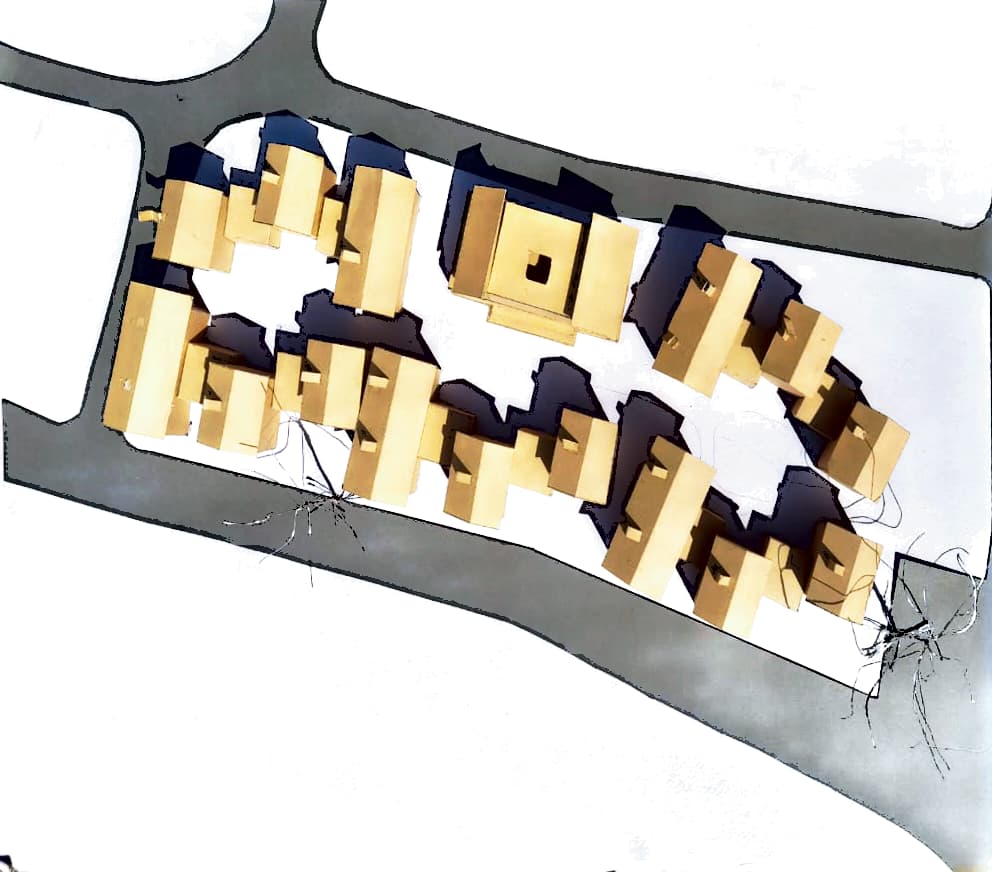 Close Knit Living Housing Design for Occupation Based Community At Yeola The handloom industry is one of the oldest and largest cottage industries in India with a 2000-year-old ancient tradition representing the vibrant Indian culture. It is said that India makes 95% of the world’s handmade textiles, unique to each geographical community within the country. …
Close Knit Living Housing Design for Occupation Based Community At Yeola The handloom industry is one of the oldest and largest cottage industries in India with a 2000-year-old ancient tradition representing the vibrant Indian culture. It is said that India makes 95% of the world’s handmade textiles, unique to each geographical community within the country. … - Ananda Aangan
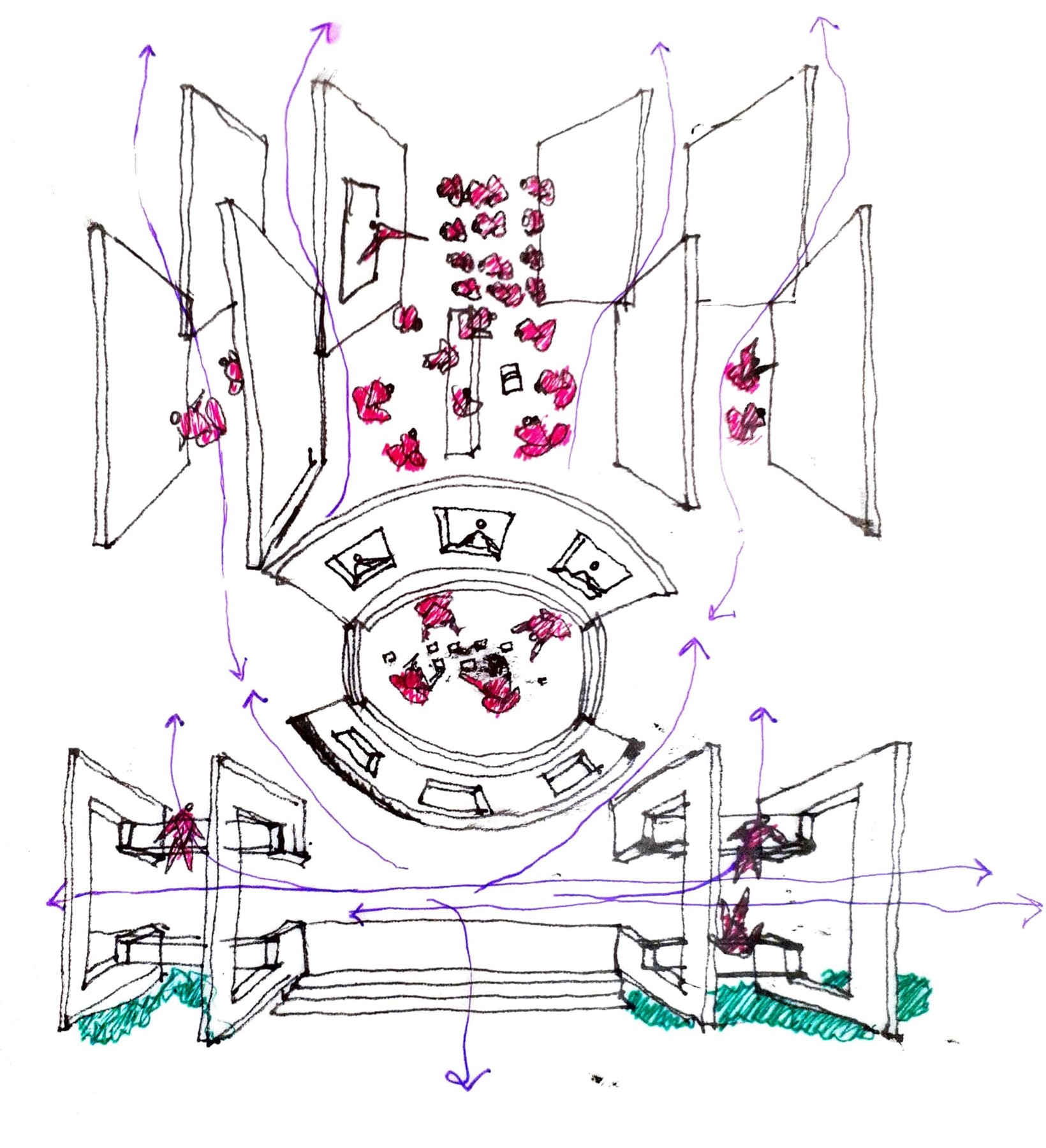 Ananda Aangan A school is a place where one learns about the totality, the wholeness of life. Academic excellence is absolutely necessary, but a school includes much more than that. It is a place where both the teacher and the taught explore not only the outer world, the world of knowledge, but also their own …
Ananda Aangan A school is a place where one learns about the totality, the wholeness of life. Academic excellence is absolutely necessary, but a school includes much more than that. It is a place where both the teacher and the taught explore not only the outer world, the world of knowledge, but also their own … - URDHVA- Socio Economic Upliftment of Tribal Community
 URDHVA- Socio Economic Upliftment of Tribal Community Tribal people who guard the forests live very sustainably, yet they are becoming more and more drawn to city life. People have lost their identities as a result of comparison and competitiveness. Although they are connected to nature, they are unable to use it to support themselves. So …
URDHVA- Socio Economic Upliftment of Tribal Community Tribal people who guard the forests live very sustainably, yet they are becoming more and more drawn to city life. People have lost their identities as a result of comparison and competitiveness. Although they are connected to nature, they are unable to use it to support themselves. So … - Preservation of Mumbai’s Maritime History
 Preservation of Mumbai’s Maritime History The port of Mumbai acted as a catalyst around which the city grew.. The areas maritime history dates as far back as the 8th BC. After the Suez Canal opened in 1869, import and export trade shifted to the east coast and Mumbai Port became the principal Gateway of India. …
Preservation of Mumbai’s Maritime History The port of Mumbai acted as a catalyst around which the city grew.. The areas maritime history dates as far back as the 8th BC. After the Suez Canal opened in 1869, import and export trade shifted to the east coast and Mumbai Port became the principal Gateway of India. … - Redevelopment of BEST Bus Depot with Mixed-Use Building
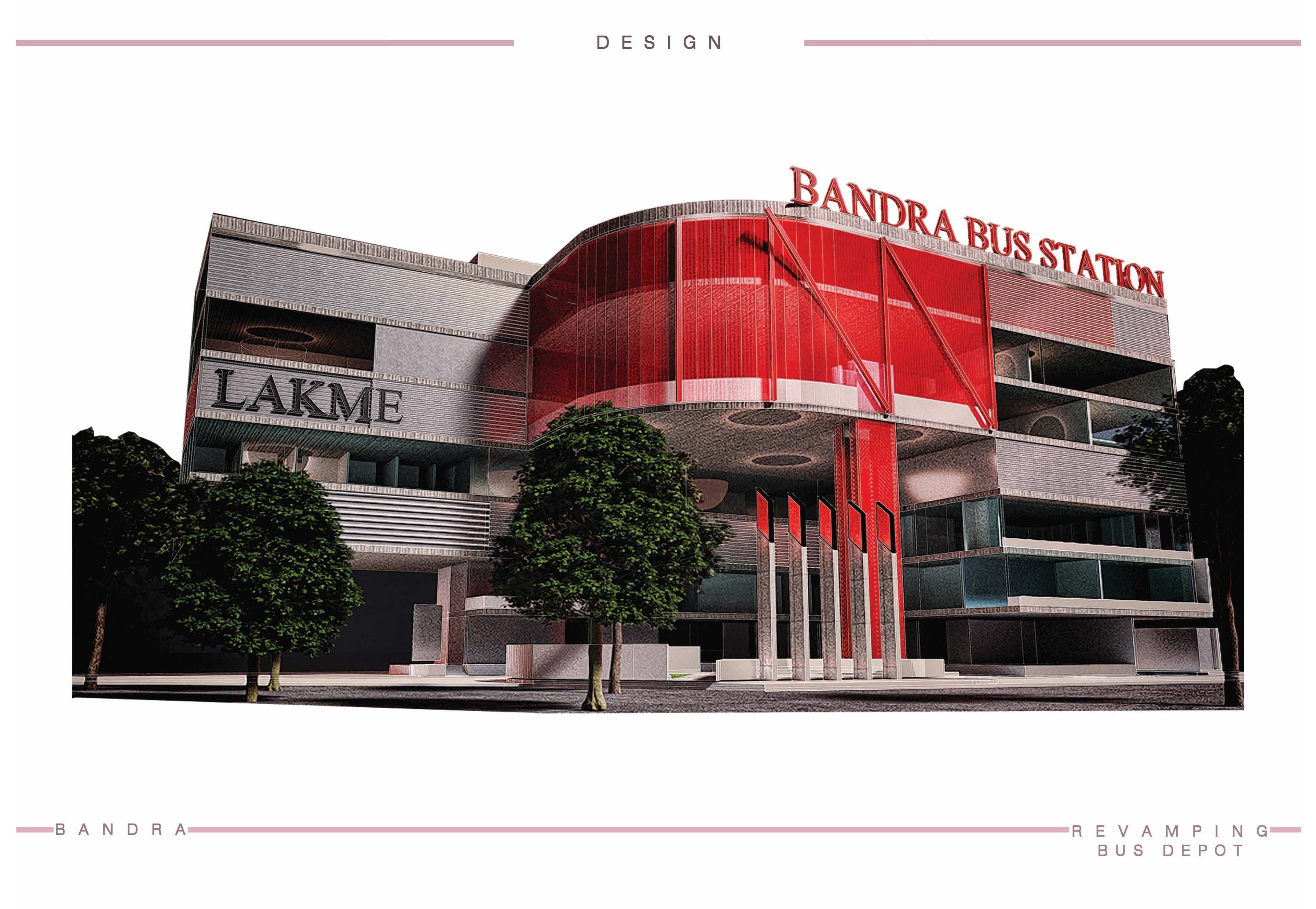 Redevelopment of BEST Bus Depot with Mixed-Use Building Semester 9 Design Studio: Proposal by Naiya Shah Mumbai, being an important urban center, has seen numerous mega investments in various sectors over the decades since independence. One of these sectors is transportation. Several large scale projects have been done since the last 10-15 years. Some of …
Redevelopment of BEST Bus Depot with Mixed-Use Building Semester 9 Design Studio: Proposal by Naiya Shah Mumbai, being an important urban center, has seen numerous mega investments in various sectors over the decades since independence. One of these sectors is transportation. Several large scale projects have been done since the last 10-15 years. Some of … - FOOD FACTORY: Reimagining Girangaon
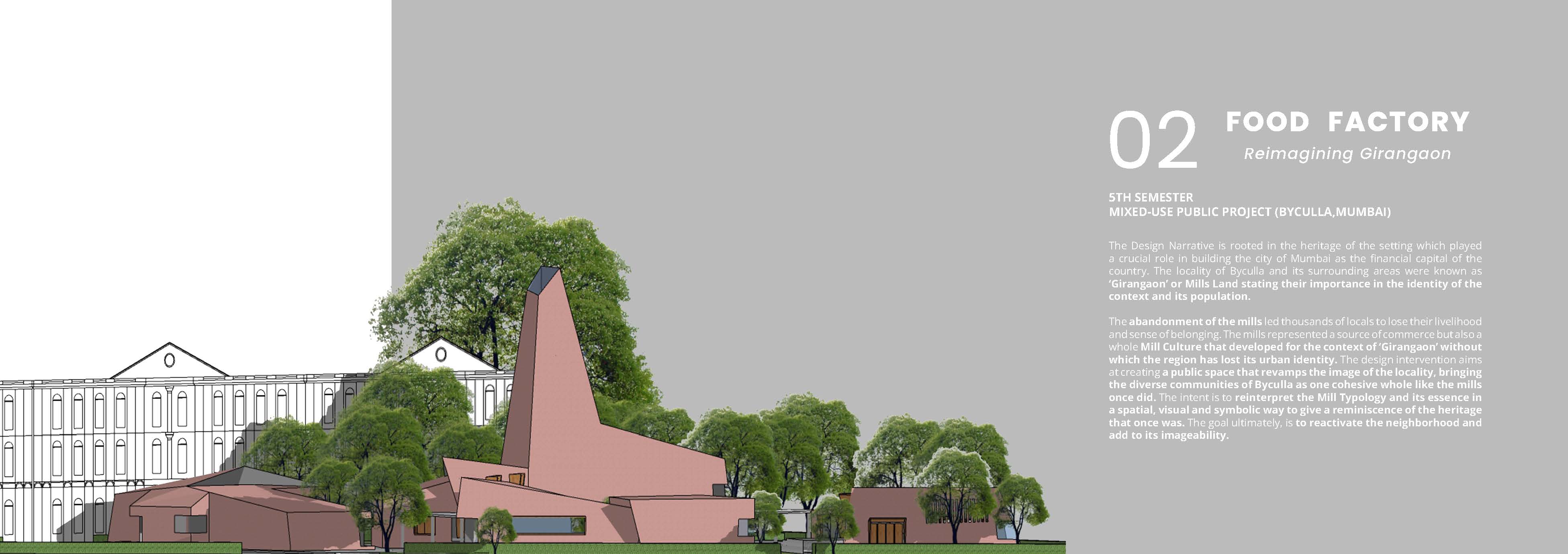 5TH SEMESTER MIXED-USE PUBLIC PROJECT (BYCULLA,MUMBAI) The Design Narrative is rooted in the heritage of the setting which played a crucial role in building the city of Mumbai as the financial capital of the country. The locality of Byculla and its surrounding areas were known as ‘Girangaon’ or Mills Land stating their importance in the …
5TH SEMESTER MIXED-USE PUBLIC PROJECT (BYCULLA,MUMBAI) The Design Narrative is rooted in the heritage of the setting which played a crucial role in building the city of Mumbai as the financial capital of the country. The locality of Byculla and its surrounding areas were known as ‘Girangaon’ or Mills Land stating their importance in the … - ĀVĀSYAM – The place of living
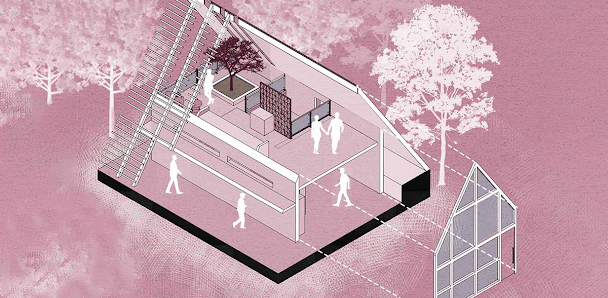 (Semester 4) THE DESIGN BRIEF: BACKGROUND SYAMANTAK In such ecologically sensitive & culturally rich setting of Dhamapur village, Syamantak: a center for experiential, lifelong learning and sustainable living is located. “Our education is related to our Mother Earth & nobody should be forced to leave his village for bread, butter & education” – the thought forms an …
(Semester 4) THE DESIGN BRIEF: BACKGROUND SYAMANTAK In such ecologically sensitive & culturally rich setting of Dhamapur village, Syamantak: a center for experiential, lifelong learning and sustainable living is located. “Our education is related to our Mother Earth & nobody should be forced to leave his village for bread, butter & education” – the thought forms an … - Mixed-Use Residential Neighbourhood at Roha (MURN)
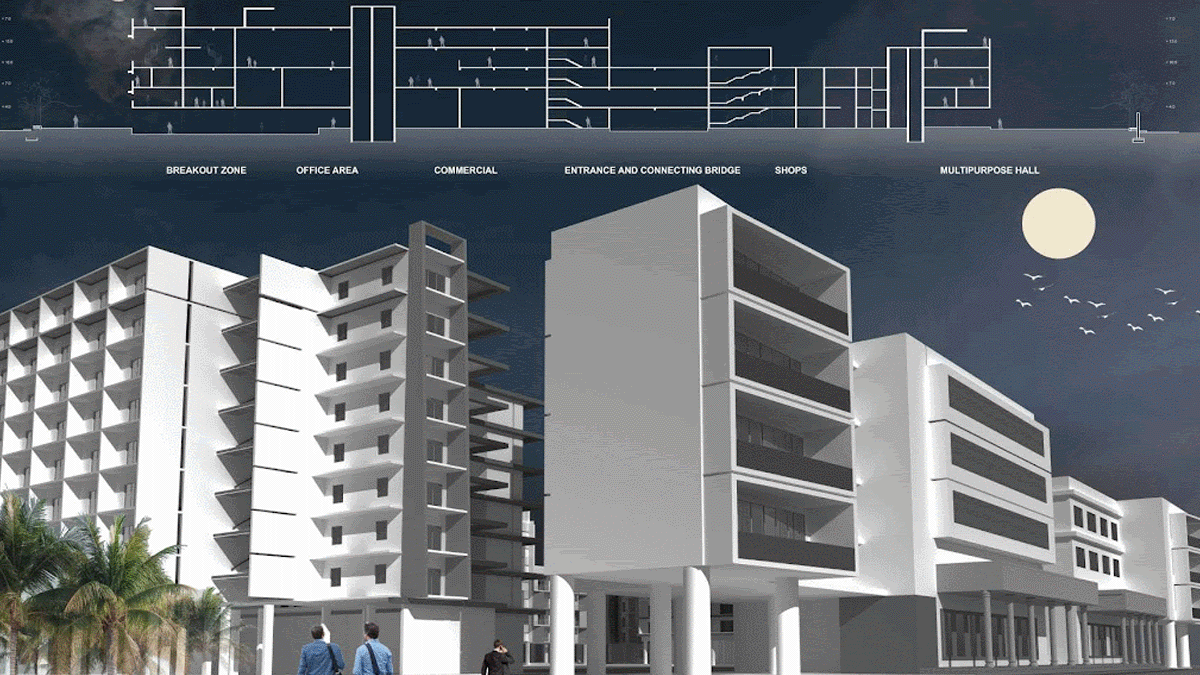 (Semester 7) Housing is the core need of human beings providing shelter, safety, privacy for them and their respective families. A community of such homes where respective families live together that provides them with security, shared space, recreation spaces, amenities, all within close vicinity, gives rise to a neighbourhood. It provides the residents with social …
(Semester 7) Housing is the core need of human beings providing shelter, safety, privacy for them and their respective families. A community of such homes where respective families live together that provides them with security, shared space, recreation spaces, amenities, all within close vicinity, gives rise to a neighbourhood. It provides the residents with social … - Science Gallery, TIFR Mumbai
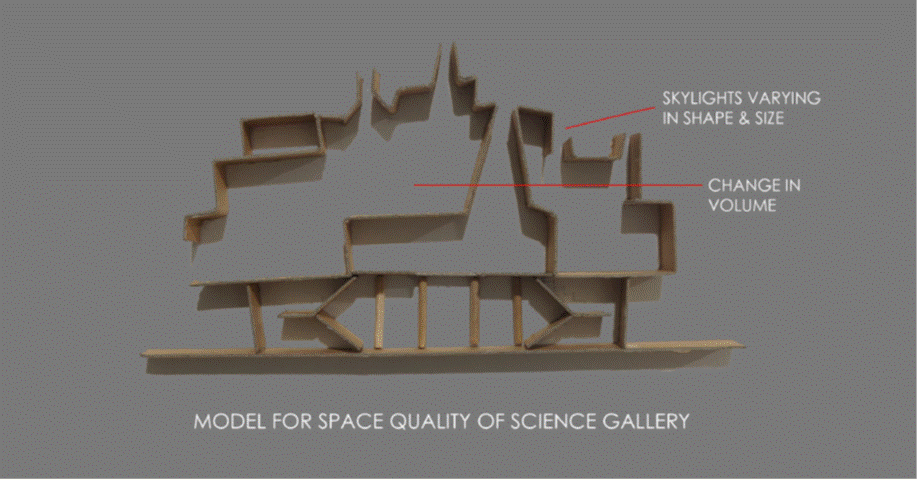 (Semester 6) Science Gallery is a public institution that delivers unique, transdisciplinaryexhibitions, events and educational programmes that engage millions of inquiring minds every year in connective, participative, and surprising ways. It offers a social space to develop ideas, imagine the future, and realise dreams. Bringing science, art, technology and design together, Science Gallery ignites a …
(Semester 6) Science Gallery is a public institution that delivers unique, transdisciplinaryexhibitions, events and educational programmes that engage millions of inquiring minds every year in connective, participative, and surprising ways. It offers a social space to develop ideas, imagine the future, and realise dreams. Bringing science, art, technology and design together, Science Gallery ignites a … - FORUM: Re-imagined
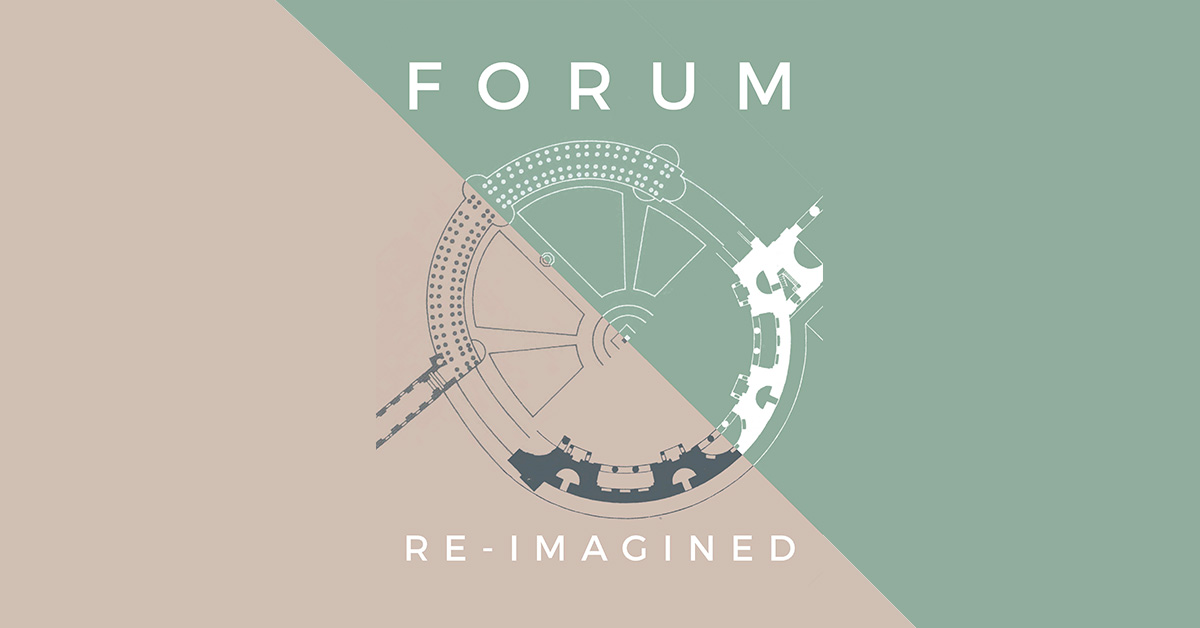 (Semester 5)Architectural Design Project The purpose of this design studio will be to learn the development of spacesand their composition for the corresponding various activities in an urbansetting. The end result of this studio will be an ideal public place that issafe, sociable, and accessible to all. It needs to respond appropriately to thesettings and …
(Semester 5)Architectural Design Project The purpose of this design studio will be to learn the development of spacesand their composition for the corresponding various activities in an urbansetting. The end result of this studio will be an ideal public place that issafe, sociable, and accessible to all. It needs to respond appropriately to thesettings and … - Basic Design
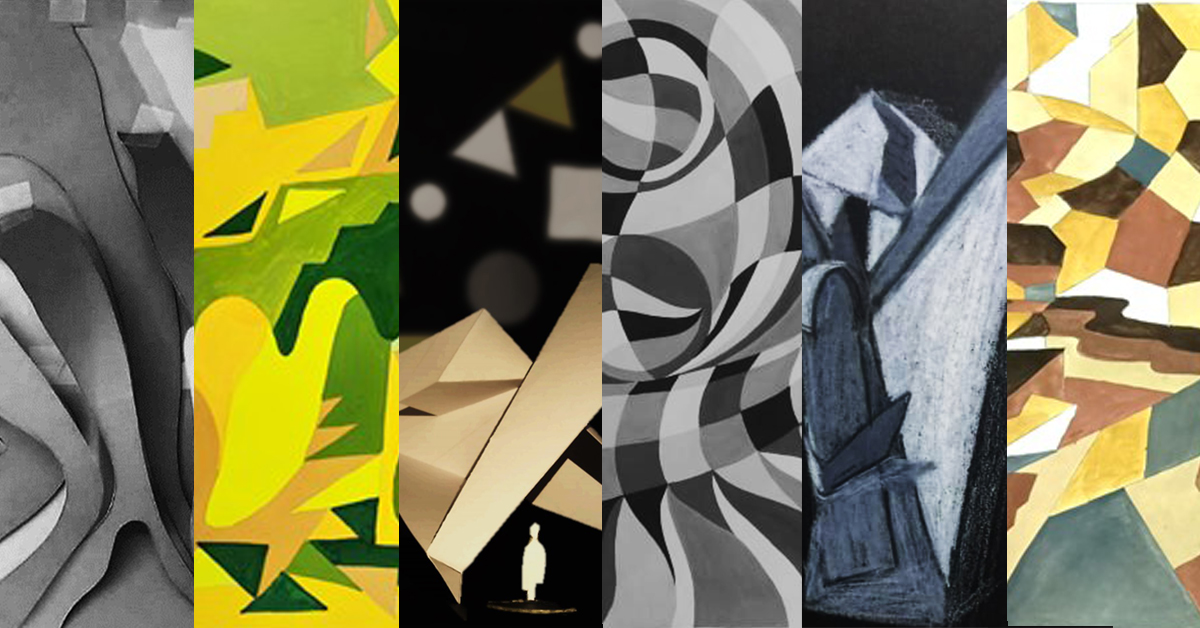 Allied Design Studio Projects by Students of Semester 1, 2020-21 Introduction to the Exercises 1. Principles of Design Design is defined as any visually pleasing, artistic and creative composition. However, design cannot be confined within these verbal walls. The concept of design is very ambiguous and, thus, hard to be put into words that could …
Allied Design Studio Projects by Students of Semester 1, 2020-21 Introduction to the Exercises 1. Principles of Design Design is defined as any visually pleasing, artistic and creative composition. However, design cannot be confined within these verbal walls. The concept of design is very ambiguous and, thus, hard to be put into words that could … - The Survival Cube
 Architectural Design Studio Projects by Students of Semester 1, 2020-21 With the world at a standstill where people were stuck in their homes, looking for an escape while escaping from a virus at the same time, one’s imagination power was the only superpower that could take one places. Freedom, in some sense, is created by …
Architectural Design Studio Projects by Students of Semester 1, 2020-21 With the world at a standstill where people were stuck in their homes, looking for an escape while escaping from a virus at the same time, one’s imagination power was the only superpower that could take one places. Freedom, in some sense, is created by … - Reminiscence of the Lost River: Revitalization of the Riverfront of Saraswati
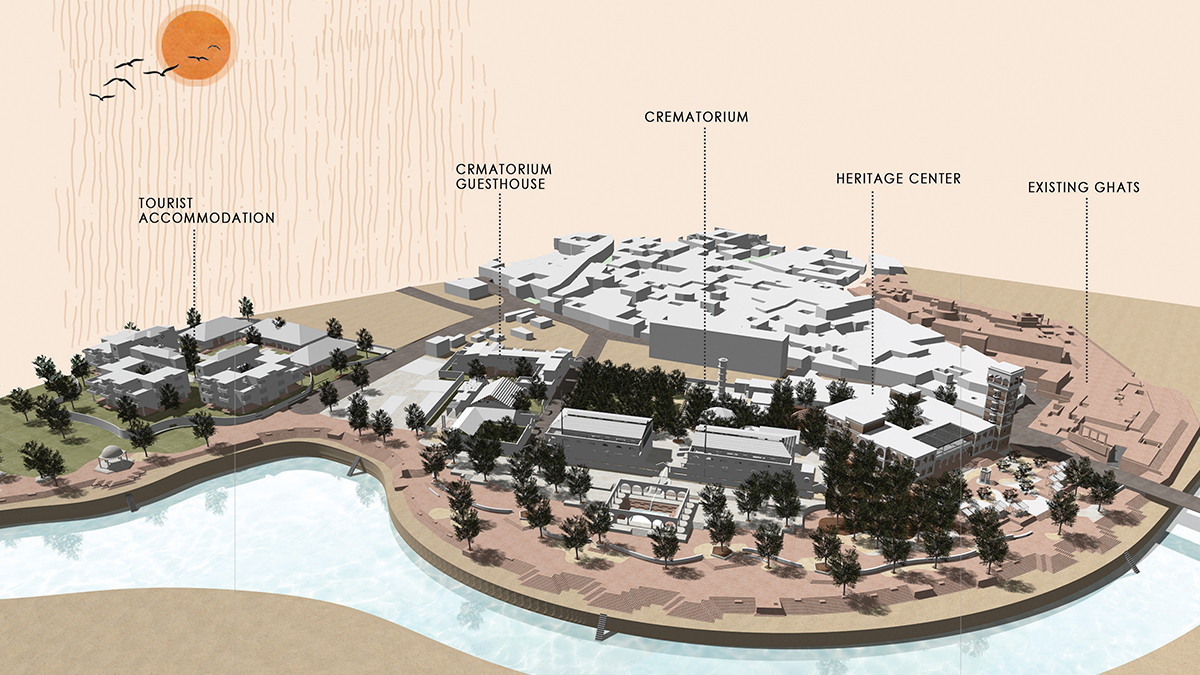 Design Dissertation: Sanika Divekar Guide: Suneeta Samant Culture is nothing but the way of living and beliefs of people passed down from one generation to another. Culture of any community is responsible for the ways spaces are shaped and thus leading to architectural developments. In the era of globalisation and urbanization, the concept of identity …
Design Dissertation: Sanika Divekar Guide: Suneeta Samant Culture is nothing but the way of living and beliefs of people passed down from one generation to another. Culture of any community is responsible for the ways spaces are shaped and thus leading to architectural developments. In the era of globalisation and urbanization, the concept of identity … - Reflections of the Past: Conserving the Cultural Heritage of the Villages of Mattur- Hosahalli
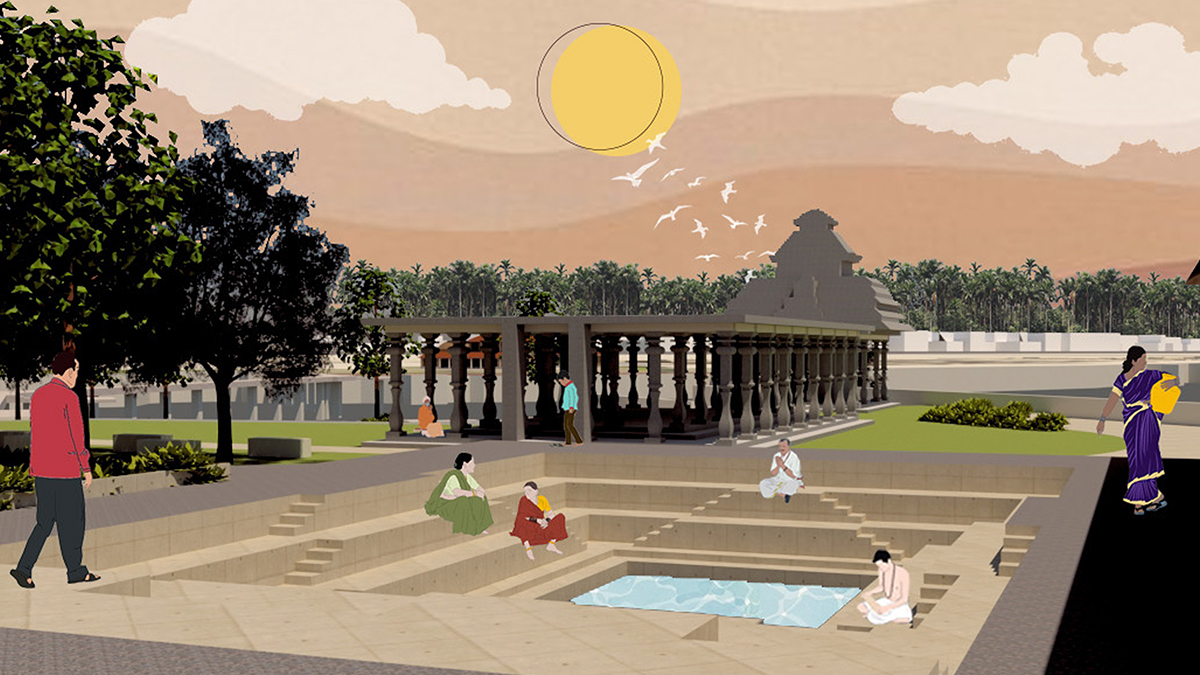 Design Dissertation: Anagha Pandit Guide: Suneeta Samant Languages play a very important role in our lives. They help us convey, express, and interact with one another. Sanskrit is one of the oldest known languages and is considered the mother of all languages in India. There have been conflicting opinions about the language being just a …
Design Dissertation: Anagha Pandit Guide: Suneeta Samant Languages play a very important role in our lives. They help us convey, express, and interact with one another. Sanskrit is one of the oldest known languages and is considered the mother of all languages in India. There have been conflicting opinions about the language being just a … - The Sanctum of Salvation: A Retreat for Mental Well-beingDesign Dissertation: Raveena Batham Guide: Vinit Mirkar Depression (n); Picture this- Being trapped at the bottom of a borewell with no escape, the lid shutting inch by inch every day, making it harder to see, with a tiny hole which happens to be the only source of light, but the darkness engulfs your entire being, …
- RE-THINKING Architectural Heritage: A Case of Watson Hotel Building
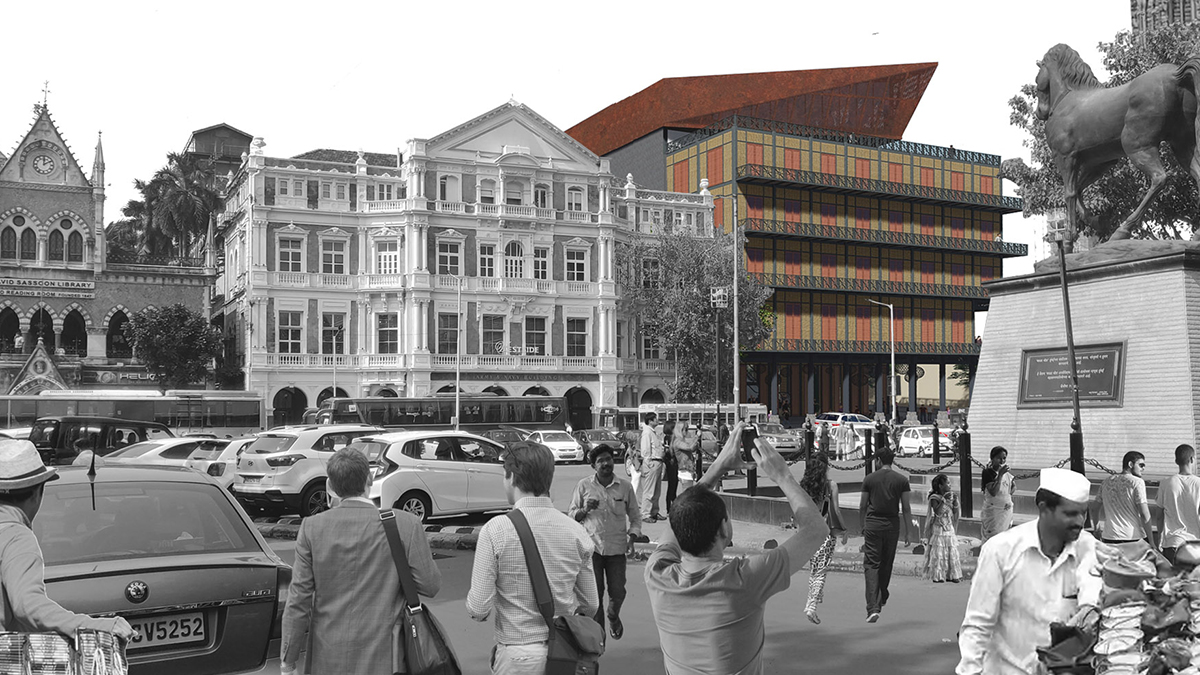 Design Dissertation: Trushad Poladia Guide: Siddharth Shirur Discussions on the topic of heritage buildings, for long, have been very jejune. The lack of exploration on the subject has often left us with two options, demolishing the old building in favour of a new building which is usually insensitive to the building that preceded it and …
Design Dissertation: Trushad Poladia Guide: Siddharth Shirur Discussions on the topic of heritage buildings, for long, have been very jejune. The lack of exploration on the subject has often left us with two options, demolishing the old building in favour of a new building which is usually insensitive to the building that preceded it and … - कल्पवृक्ष: Value Addition to the Banana Plantation of Vasai through Agro Industry
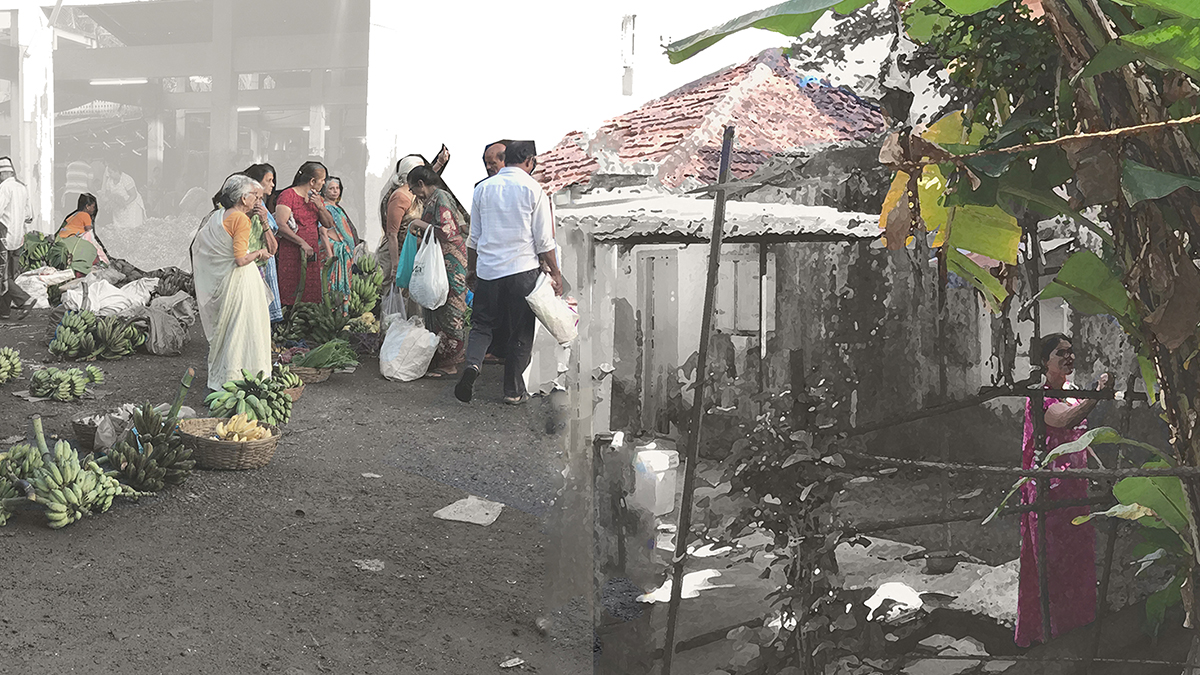 Design Dissertation: Shriya Vartak Guide: Vinit Mirkar Agriculture is the main occupation of the majority populace. The value for agricultural produce depends on the demand and market value. In today’s time, the field of agriculture is experiencing a gradual decrease. Poor handlings, inflation, less opportunities for post processing, improper disposal of agriculture waste, etc. are …
Design Dissertation: Shriya Vartak Guide: Vinit Mirkar Agriculture is the main occupation of the majority populace. The value for agricultural produce depends on the demand and market value. In today’s time, the field of agriculture is experiencing a gradual decrease. Poor handlings, inflation, less opportunities for post processing, improper disposal of agriculture waste, etc. are … - Silk Sanyog: Unifying Silk and its People
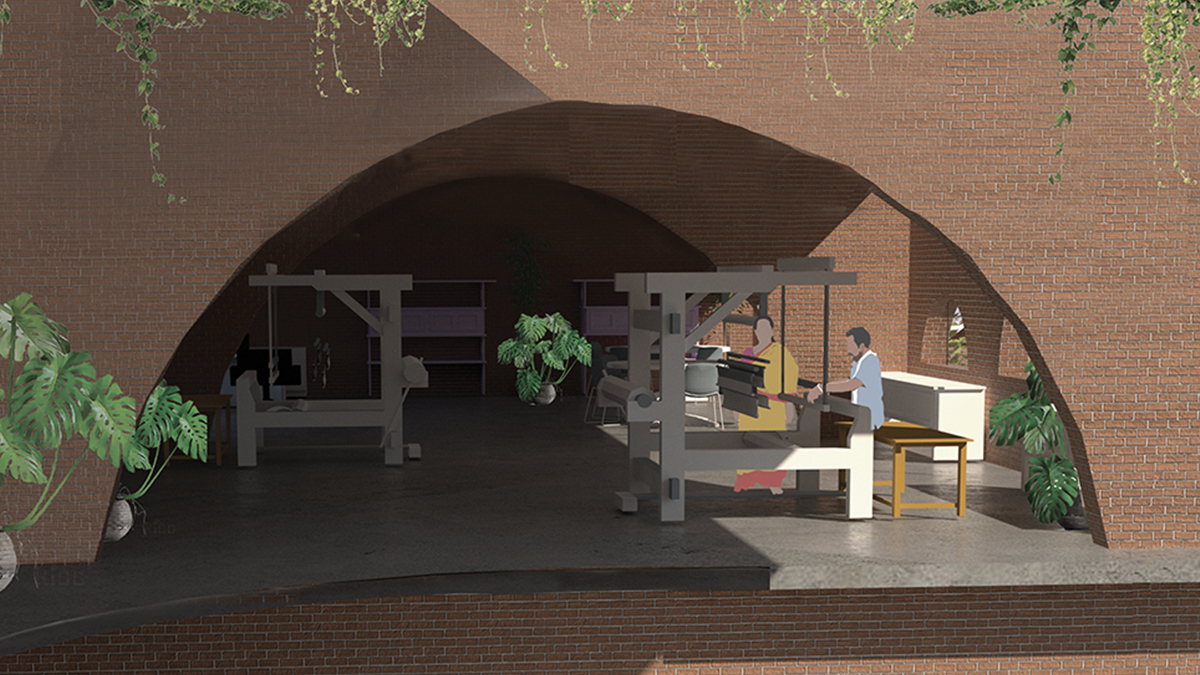 Design Dissertation: Madhuli Awasarkar Guide: Shilpa Sharma Silk The use of silk has long been a synonym for grandeur and a status symbol. People, art forms, history, mythology, diverse culture have influenced silk as a textile and thus it also embodies diversity and richness of textiles in Indian culture. Sericulture to silk is a long …
Design Dissertation: Madhuli Awasarkar Guide: Shilpa Sharma Silk The use of silk has long been a synonym for grandeur and a status symbol. People, art forms, history, mythology, diverse culture have influenced silk as a textile and thus it also embodies diversity and richness of textiles in Indian culture. Sericulture to silk is a long … - Configuring Historic Nodes: Case of Orchha
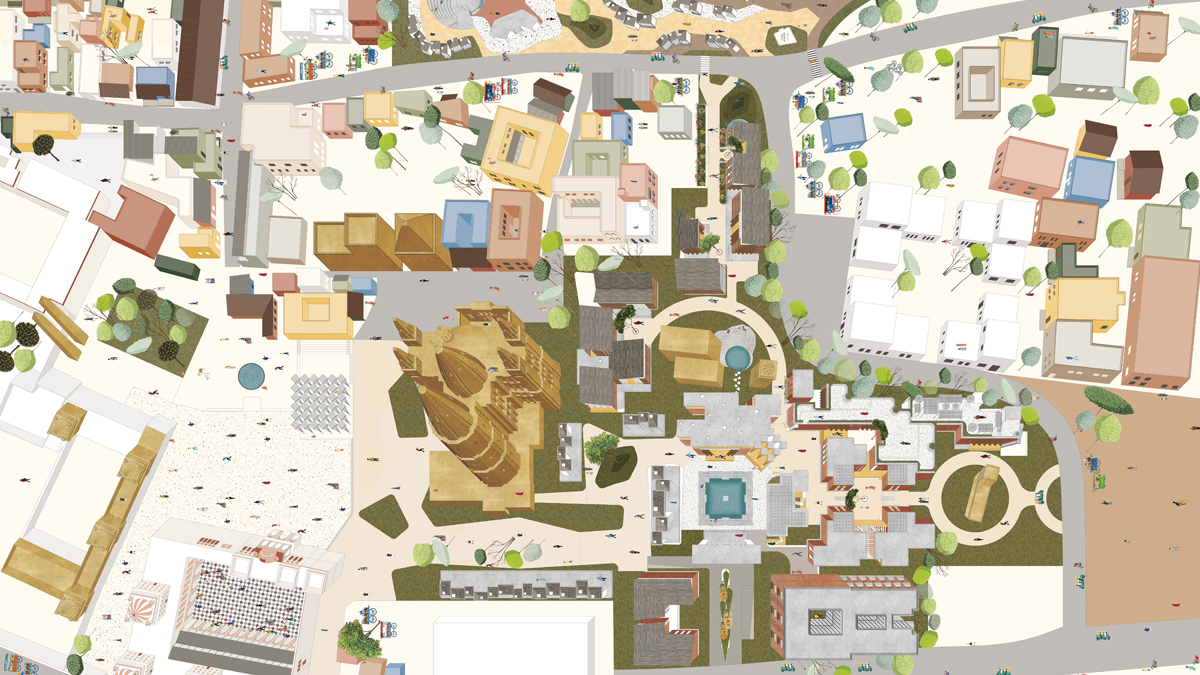 Design Dissertation: Devika Kale Guide: Shilpa Chandawarkar The fabric of any Indian city has multiple layers. Each layer speaks of a bygone era it witnessed. These layers are a crucial link between the past and the present and it plays an essential role in shaping future development. Heritage is typically associated with built structures, but …
Design Dissertation: Devika Kale Guide: Shilpa Chandawarkar The fabric of any Indian city has multiple layers. Each layer speaks of a bygone era it witnessed. These layers are a crucial link between the past and the present and it plays an essential role in shaping future development. Heritage is typically associated with built structures, but … - Urban Manifesto X: The Statues We NeedDesign Dissertation: Sumedh Gangurde Guide: Siddharth Shirur Urban Manifesto: A term coined by the author, by combining two words to describe a new concept which briefly means creating a public declaration of policy and aims but of a physical form circulating the urban environment. Aim This dissertation debates about the current socio-political conflict often sprung …
- Housing in Quaiserbagh: Kunal BhatijaThe Design aims at redefining the traditional architectural elements by designing them in a modern way. Considering the idea of traditional forts and palaces having a huge central courtyard at the entrance, the Nagar Nigam is divided into 3 zones: Public, Private, and Semi-Private with a maximum visual connection between them. The rhythm of having continuous jaali on the facade in traditional architecture is designed in a modern way that facilitates daylight to all the interior public spaces and offices and provides views towards the surroundings and the central courtyard.
- Housing in Quaiserbagh: Muskan Jain
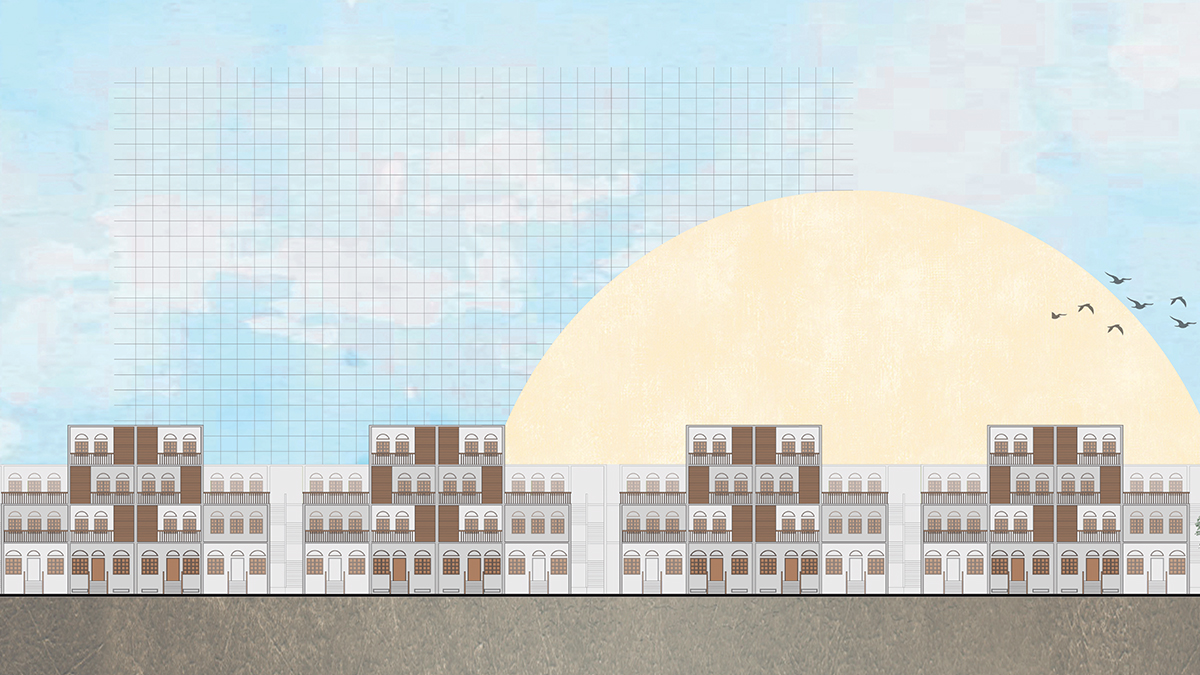 The Design aims at redefining the traditional architectural elements by designing them in a modern way. Considering the idea of traditional forts and palaces having a huge central courtyard at the entrance, the Nagar Nigam is divided into 3 zones: Public, Private, and Semi-Private with a maximum visual connection between them. The rhythm of having continuous jaali on the facade in traditional architecture is designed in a modern way that facilitates daylight to all the interior public spaces and offices and provides views towards the surroundings and the central courtyard.
The Design aims at redefining the traditional architectural elements by designing them in a modern way. Considering the idea of traditional forts and palaces having a huge central courtyard at the entrance, the Nagar Nigam is divided into 3 zones: Public, Private, and Semi-Private with a maximum visual connection between them. The rhythm of having continuous jaali on the facade in traditional architecture is designed in a modern way that facilitates daylight to all the interior public spaces and offices and provides views towards the surroundings and the central courtyard. - Housing in Quaiserbagh: Dhruvin Shah
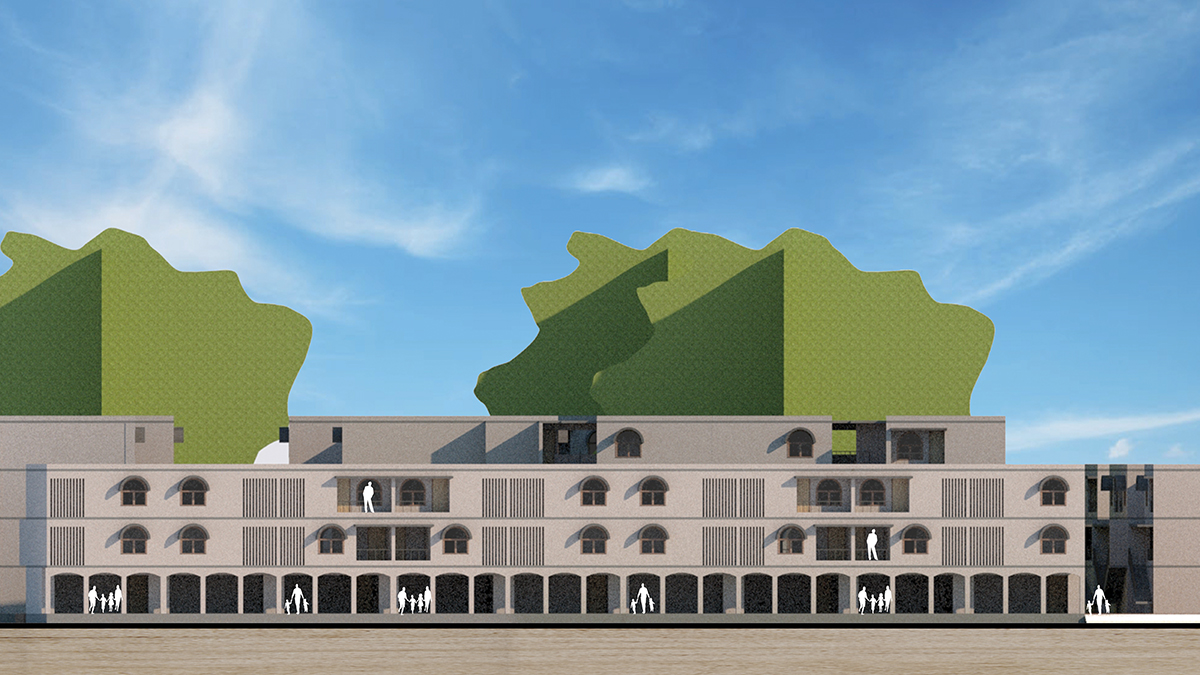 The Design aims at redefining the traditional architectural elements by designing them in a modern way. Considering the idea of traditional forts and palaces having a huge central courtyard at the entrance, the Nagar Nigam is divided into 3 zones: Public, Private, and Semi-Private with a maximum visual connection between them. The rhythm of having continuous jaali on the facade in traditional architecture is designed in a modern way that facilitates daylight to all the interior public spaces and offices and provides views towards the surroundings and the central courtyard.
The Design aims at redefining the traditional architectural elements by designing them in a modern way. Considering the idea of traditional forts and palaces having a huge central courtyard at the entrance, the Nagar Nigam is divided into 3 zones: Public, Private, and Semi-Private with a maximum visual connection between them. The rhythm of having continuous jaali on the facade in traditional architecture is designed in a modern way that facilitates daylight to all the interior public spaces and offices and provides views towards the surroundings and the central courtyard. - Housing in Quaiserbagh: Niharika Parkar
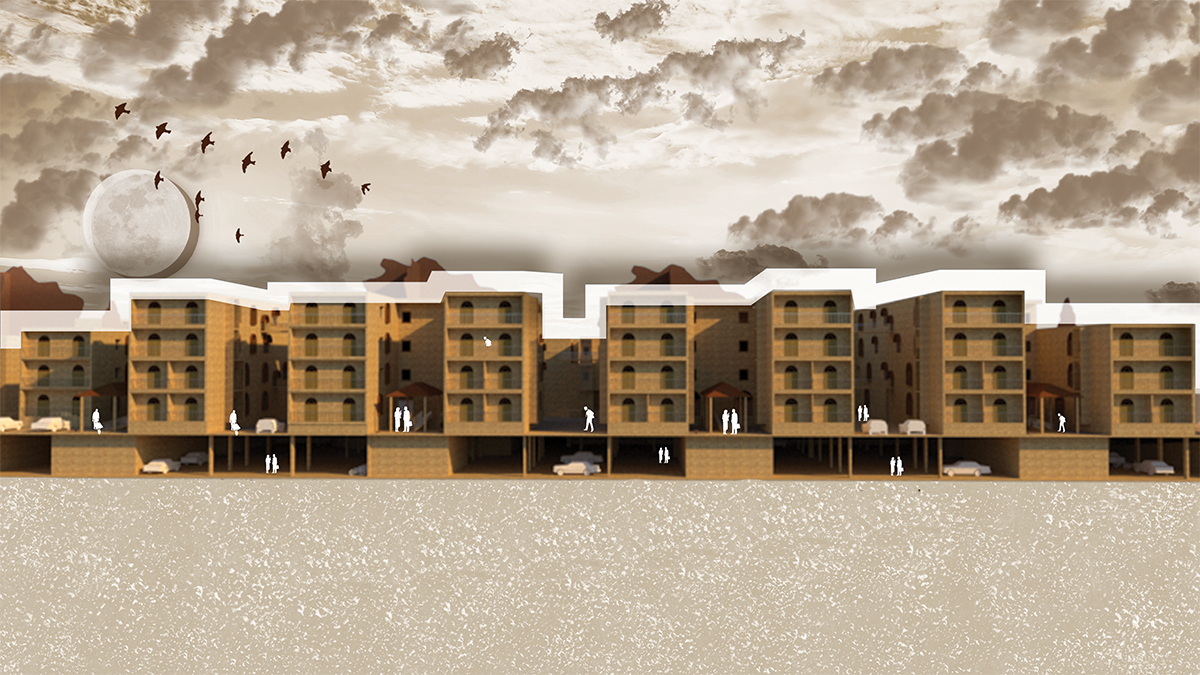 The Design aims at redefining the traditional architectural elements by designing them in a modern way. Considering the idea of traditional forts and palaces having a huge central courtyard at the entrance, the Nagar Nigam is divided into 3 zones: Public, Private, and Semi-Private with a maximum visual connection between them. The rhythm of having continuous jaali on the facade in traditional architecture is designed in a modern way that facilitates daylight to all the interior public spaces and offices and provides views towards the surroundings and the central courtyard.
The Design aims at redefining the traditional architectural elements by designing them in a modern way. Considering the idea of traditional forts and palaces having a huge central courtyard at the entrance, the Nagar Nigam is divided into 3 zones: Public, Private, and Semi-Private with a maximum visual connection between them. The rhythm of having continuous jaali on the facade in traditional architecture is designed in a modern way that facilitates daylight to all the interior public spaces and offices and provides views towards the surroundings and the central courtyard. - Housing in Quaiserbagh: Charmie Daftary
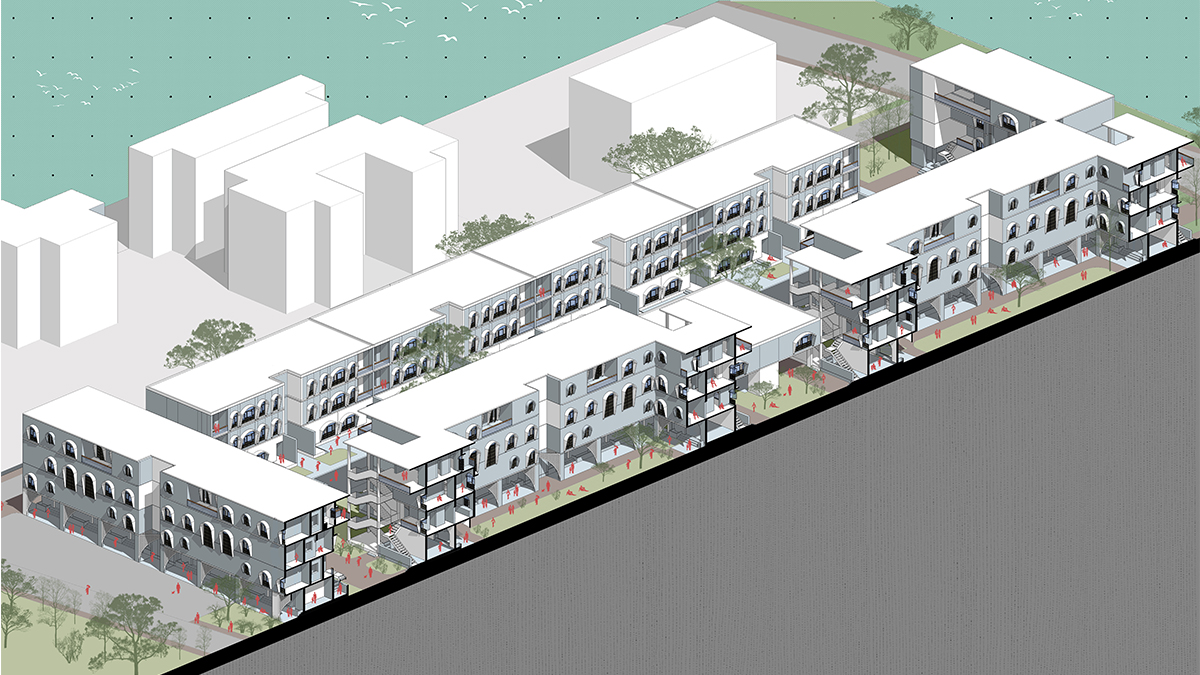 The Design aims at redefining the traditional architectural elements by designing them in a modern way. Considering the idea of traditional forts and palaces having a huge central courtyard at the entrance, the Nagar Nigam is divided into 3 zones: Public, Private, and Semi-Private with a maximum visual connection between them. The rhythm of having continuous jaali on the facade in traditional architecture is designed in a modern way that facilitates daylight to all the interior public spaces and offices and provides views towards the surroundings and the central courtyard.
The Design aims at redefining the traditional architectural elements by designing them in a modern way. Considering the idea of traditional forts and palaces having a huge central courtyard at the entrance, the Nagar Nigam is divided into 3 zones: Public, Private, and Semi-Private with a maximum visual connection between them. The rhythm of having continuous jaali on the facade in traditional architecture is designed in a modern way that facilitates daylight to all the interior public spaces and offices and provides views towards the surroundings and the central courtyard. - Jaipur Nagar Nigam: Heena Chaudhari
 The Design aims at redefining the traditional architectural elements by designing them in a modern way. Considering the idea of traditional forts and palaces having a huge central courtyard at the entrance, the Nagar Nigam is divided into 3 zones: Public, Private, and Semi-Private with a maximum visual connection between them. The rhythm of having continuous jaali on the facade in traditional architecture is designed in a modern way that facilitates daylight to all the interior public spaces and offices and provides views towards the surroundings and the central courtyard.
The Design aims at redefining the traditional architectural elements by designing them in a modern way. Considering the idea of traditional forts and palaces having a huge central courtyard at the entrance, the Nagar Nigam is divided into 3 zones: Public, Private, and Semi-Private with a maximum visual connection between them. The rhythm of having continuous jaali on the facade in traditional architecture is designed in a modern way that facilitates daylight to all the interior public spaces and offices and provides views towards the surroundings and the central courtyard. - Jaipur Nagar Nigam: Ria Mehta
 As the corporate world is seamlessly transitioning to a ‘flat’ organisational structure, owing to its multiple benefits, the public sector is yet stuck with the age-old hierarchical constructs. This design attempts to create a more equitable, inclusive workspace for all employees of the Jaipur Nagar Nigam. While the sahebs have retained their individual cabins and facilities, the operational staff which is the backbone of JNN have been accorded more amenities and open spaces, to empower and encourage them in their daily roles.
As the corporate world is seamlessly transitioning to a ‘flat’ organisational structure, owing to its multiple benefits, the public sector is yet stuck with the age-old hierarchical constructs. This design attempts to create a more equitable, inclusive workspace for all employees of the Jaipur Nagar Nigam. While the sahebs have retained their individual cabins and facilities, the operational staff which is the backbone of JNN have been accorded more amenities and open spaces, to empower and encourage them in their daily roles. - Jaipur Nagar Nigam: Mihir Vaidya
 Based in Jaipur, a new Nagar Nigam design proposal for the old city aims at creating a similar order observed in Jaipuri architecture, in terms of its physical attributes. In this place, democracy is the most regarded, where leaders receive their deserved regard, and the people get their representation. People and their interaction amongst themselves and the structure are given utmost value in Jaipur. Thus, the structure aims at being as public-friendly but also a structure that stands apart and casts its image on the users
Based in Jaipur, a new Nagar Nigam design proposal for the old city aims at creating a similar order observed in Jaipuri architecture, in terms of its physical attributes. In this place, democracy is the most regarded, where leaders receive their deserved regard, and the people get their representation. People and their interaction amongst themselves and the structure are given utmost value in Jaipur. Thus, the structure aims at being as public-friendly but also a structure that stands apart and casts its image on the users - Jaipur Nagar Nigam: Aditya Jaju
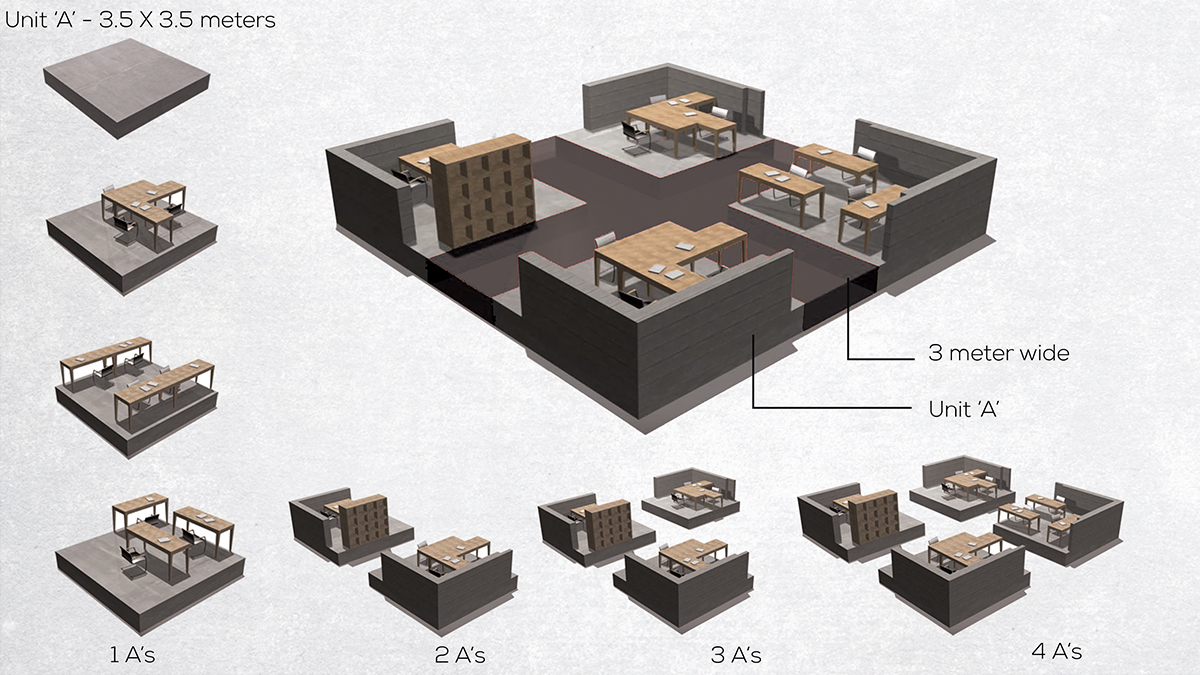 The design is a combination of grid pattern and connectivity originated in town planning of Jaipur, the first planned city in India, based on Hindu system of town planning and principles of Shilpa-shastra and a workplace in Apeldoorn the Centraal Beheer office building. Inspired by the planning and connectivity of these places, the design consists of 35 cubic elements of 10 by 10 meters each located around a core containing stairs, lifts and bathrooms. On each floor, there are two such cores with connecting corridors of 3 meters for human traffic. Each element is designed to be flexible and subject to the individual program function and its inhabitants. The building has an inter-penetrating grid of circulation and structure that leaves common space which can be modified for different purposes. These repetitions of cubic modules help in creating corridors connecting different spaces physically and visually, as well as for future development.
The design is a combination of grid pattern and connectivity originated in town planning of Jaipur, the first planned city in India, based on Hindu system of town planning and principles of Shilpa-shastra and a workplace in Apeldoorn the Centraal Beheer office building. Inspired by the planning and connectivity of these places, the design consists of 35 cubic elements of 10 by 10 meters each located around a core containing stairs, lifts and bathrooms. On each floor, there are two such cores with connecting corridors of 3 meters for human traffic. Each element is designed to be flexible and subject to the individual program function and its inhabitants. The building has an inter-penetrating grid of circulation and structure that leaves common space which can be modified for different purposes. These repetitions of cubic modules help in creating corridors connecting different spaces physically and visually, as well as for future development. - Jaipur Nagar Nigam: Rhea Surkatha
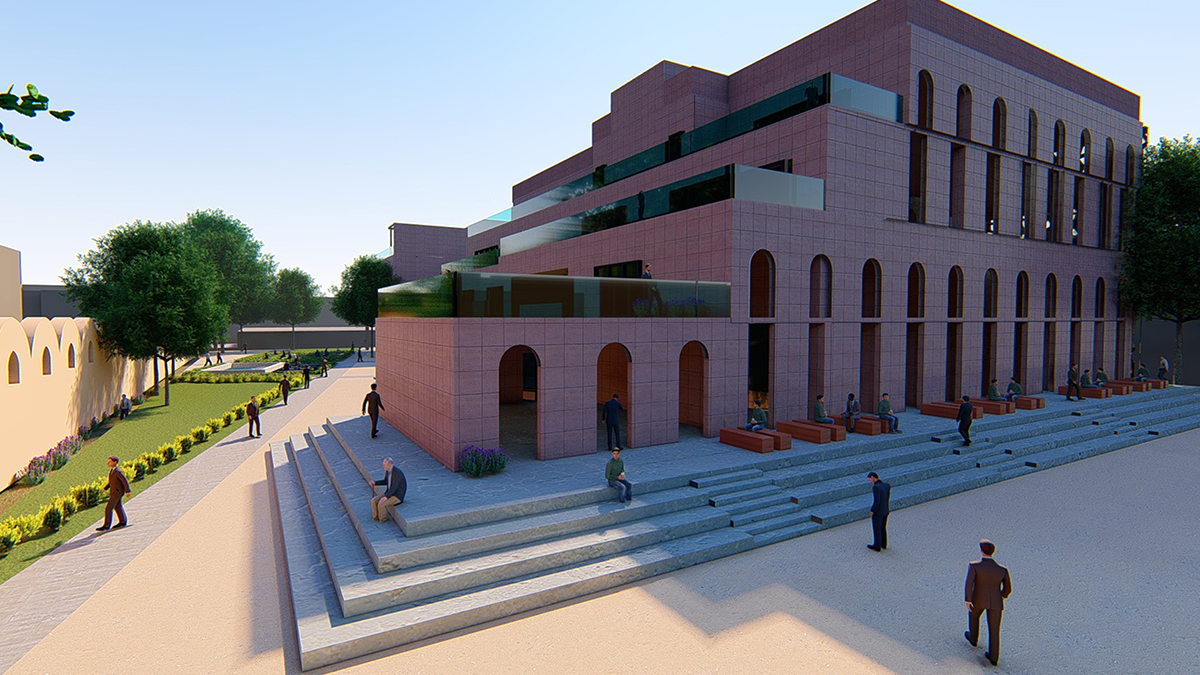 The idea was to create a public plaza that blends into the built form integrating the recreational activities along with the working spaces. All the primary functions on each floor are zoned around the staggering courtyards, which bring natural light and ventilation into the structure, and the passages around them help in visual horizontal and vertical connectivity, which help in better circulation. The hierarchy is maintained by placing the public functions on the lower floors and offices and VIP functions on the upper floors. The stepped terraces on the north façade overlooking the public plaza maintain the transparency within the structure.
The idea was to create a public plaza that blends into the built form integrating the recreational activities along with the working spaces. All the primary functions on each floor are zoned around the staggering courtyards, which bring natural light and ventilation into the structure, and the passages around them help in visual horizontal and vertical connectivity, which help in better circulation. The hierarchy is maintained by placing the public functions on the lower floors and offices and VIP functions on the upper floors. The stepped terraces on the north façade overlooking the public plaza maintain the transparency within the structure. - Jaipur Nagar Nigam: Anushka Deora
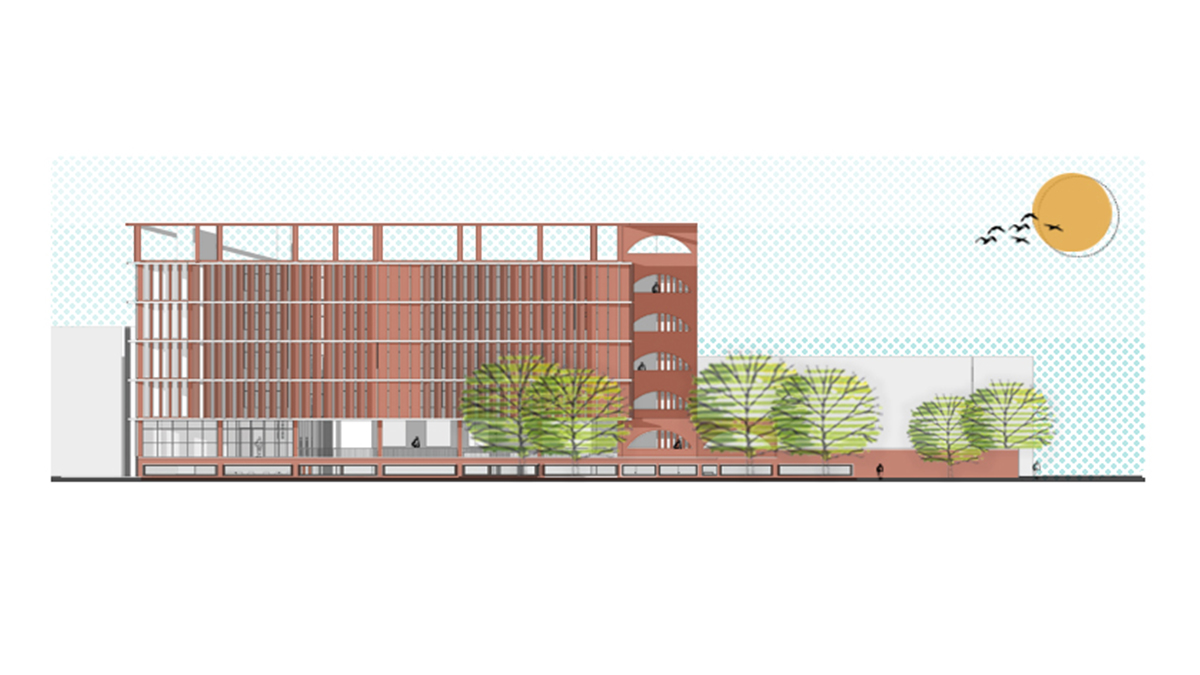 The idea of the design was to develop a public-private relationship between the Jaipur Nagar Nigam building and the people of the city, a space that could be used for municipal as well as recreational purposes. The design has provided a public space within a municipal building while also maintaining hierarchy and functioning of the offices.
The idea of the design was to develop a public-private relationship between the Jaipur Nagar Nigam building and the people of the city, a space that could be used for municipal as well as recreational purposes. The design has provided a public space within a municipal building while also maintaining hierarchy and functioning of the offices. - Jaipur Nagar Nigam: Pratik Malpure
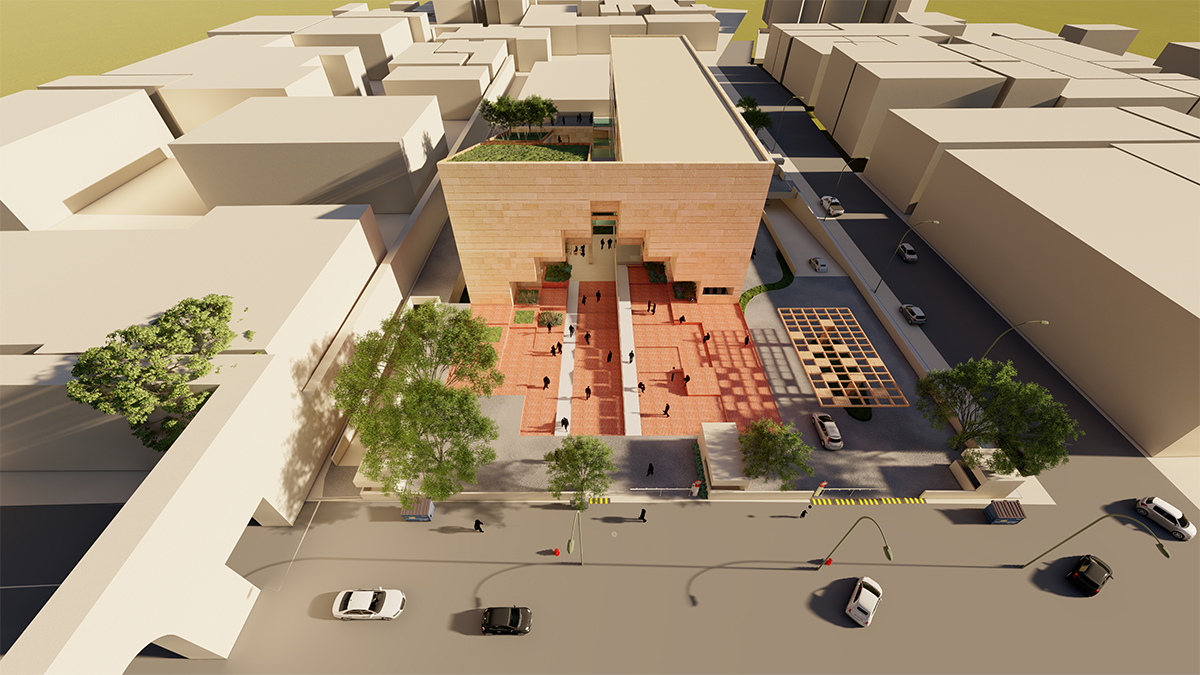 ‘समावेशक’ – The Nagar Nigam of Jaipur Enthralling, historical Jaipur, Rajasthan’s capital, is the gateway to India’s most flamboyant state. The city’s colourful, chaotic streets ebb and flow with a heady brew of old and new. This intervention celebrates the everlasting character and soul of the Pink city by re-imagining the elements that form its image. The entrance is an ode to the exquisite medieval vavs (stepwells). The waiting areas are strung together, facing the age-old traditional aangan (central courtyard). Along with these metaphorical spaces, it is the interesting play of diffused light that brings the project to life.
‘समावेशक’ – The Nagar Nigam of Jaipur Enthralling, historical Jaipur, Rajasthan’s capital, is the gateway to India’s most flamboyant state. The city’s colourful, chaotic streets ebb and flow with a heady brew of old and new. This intervention celebrates the everlasting character and soul of the Pink city by re-imagining the elements that form its image. The entrance is an ode to the exquisite medieval vavs (stepwells). The waiting areas are strung together, facing the age-old traditional aangan (central courtyard). Along with these metaphorical spaces, it is the interesting play of diffused light that brings the project to life. - Jaipur Nagar Nigam: Roshini V
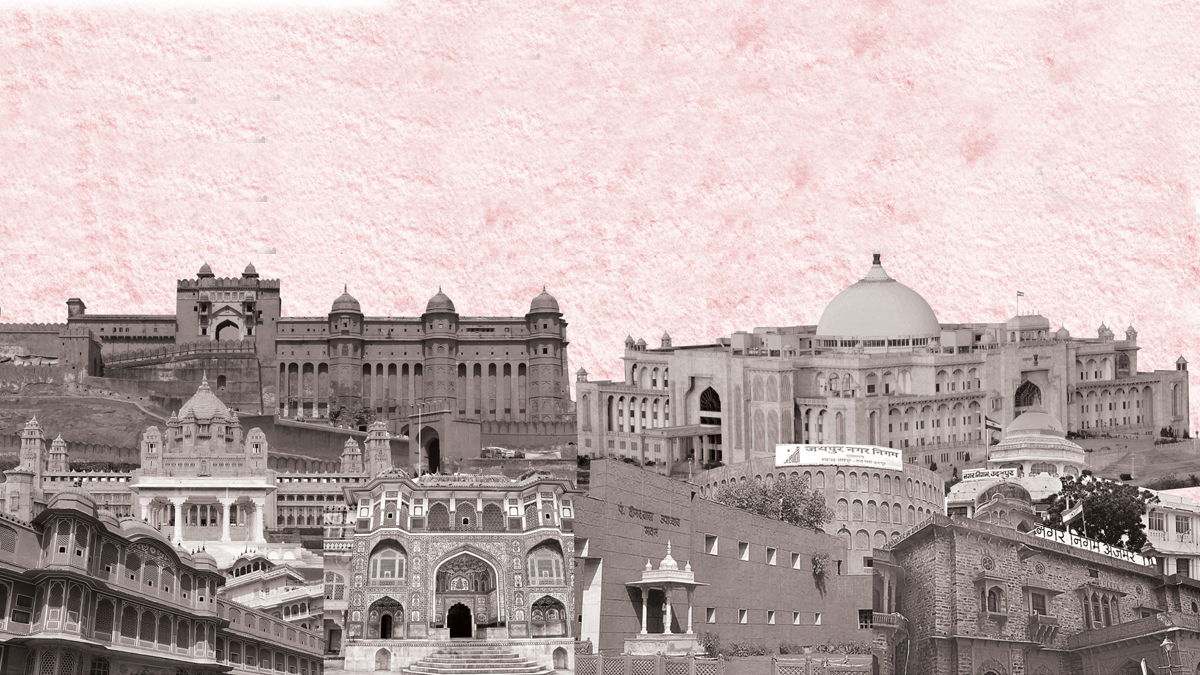 The aim was to design a municipal Corporation building that is user friendly. This structure is easy for a common man to navigate his way through and is a comfortable space for the employees to work in. There is ample visual connection with the outside which not only gives a point of reference but also helps one to locate their position inside and allows a lot of natural light to enter into the circulation spaces. There are several courtyards in the structure that act as light wells. Courtyards are also vegetated in order to bring the feeling of outside into the inside of the structure. This, along with the jalis on the external walls of the rooms of the employees, helps in keeping the structure cool and comfortable for the people working throughout the day. The facade has a flat archway that is inspired by old buildings of Jaipur, and this helps it blend with the context.
The aim was to design a municipal Corporation building that is user friendly. This structure is easy for a common man to navigate his way through and is a comfortable space for the employees to work in. There is ample visual connection with the outside which not only gives a point of reference but also helps one to locate their position inside and allows a lot of natural light to enter into the circulation spaces. There are several courtyards in the structure that act as light wells. Courtyards are also vegetated in order to bring the feeling of outside into the inside of the structure. This, along with the jalis on the external walls of the rooms of the employees, helps in keeping the structure cool and comfortable for the people working throughout the day. The facade has a flat archway that is inspired by old buildings of Jaipur, and this helps it blend with the context. - Jaipur Nagar Nigam: Vihaan Shah
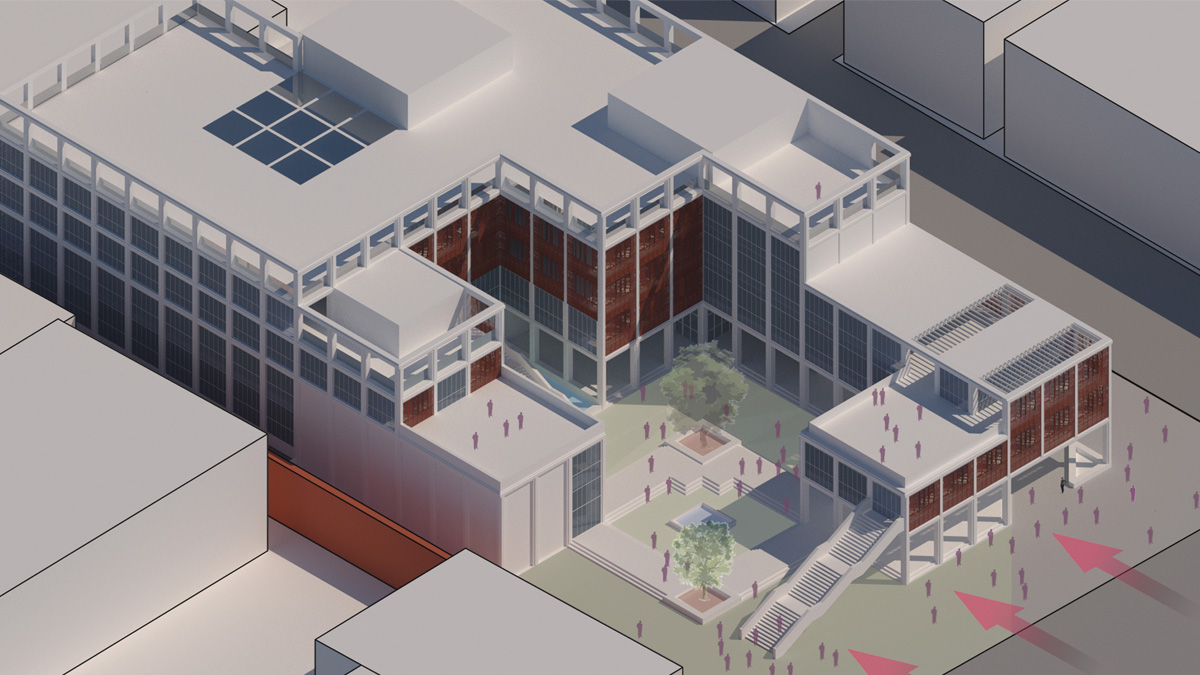 “The site for the Jaipur Nagar Nigam was adjacent to the Jorawar Singh Gate, one of the main entry points into the city. Taking inspiration from the square grid of the mandala which the city was based upon I used a 12 by 12-meter grid to stack up cuboid volumes that step down towards the gate intending to integrate a Public Space with the fabric of the built form. The idea was the transparency of the process of government which unfolds through the seamless connection of the plaza, exhibition area and viewing gallery into the assembly hall. This is almost like an exhibit within itself which visitors can enjoy while walking around the building.”
“The site for the Jaipur Nagar Nigam was adjacent to the Jorawar Singh Gate, one of the main entry points into the city. Taking inspiration from the square grid of the mandala which the city was based upon I used a 12 by 12-meter grid to stack up cuboid volumes that step down towards the gate intending to integrate a Public Space with the fabric of the built form. The idea was the transparency of the process of government which unfolds through the seamless connection of the plaza, exhibition area and viewing gallery into the assembly hall. This is almost like an exhibit within itself which visitors can enjoy while walking around the building.” - Jaipur Nagar Nigam: Vaibhavi Shirsat
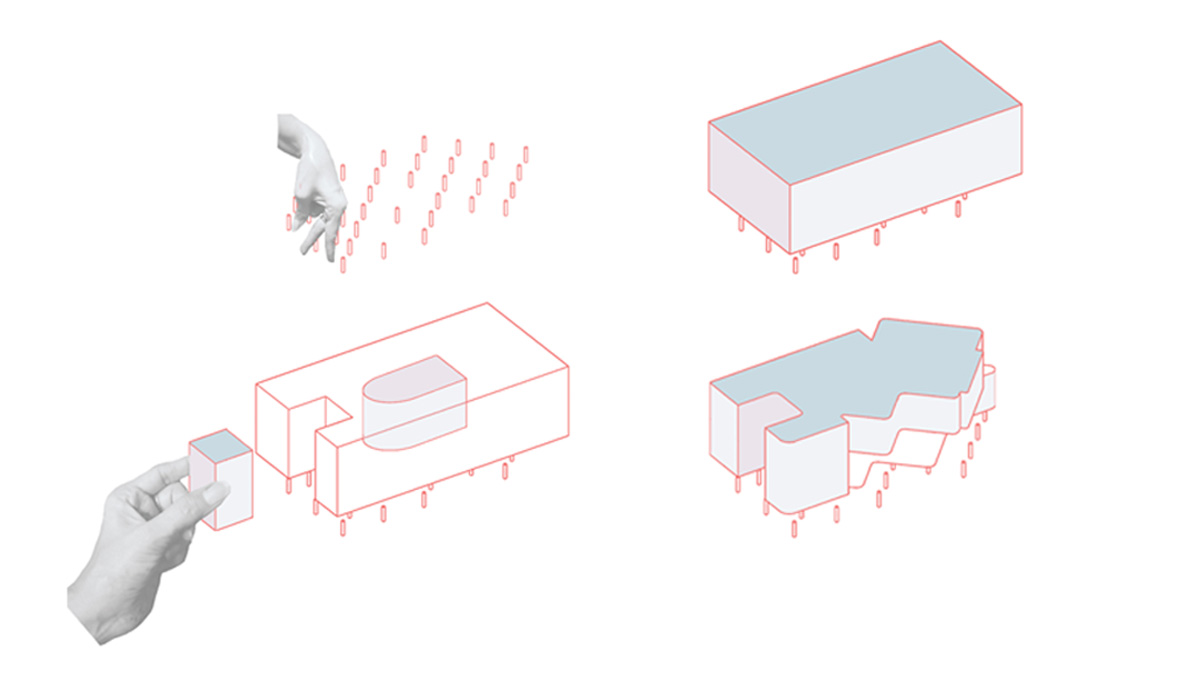 “The design concept for the Jaipur Nagar Nigam focuses on the exercise of democracy as a transparent activity. In addition to being a place of authority, it also needs to make its citizens feel like their own and hence the transition of spaces vertically, resembles the hierarchy of spaces that one sees in one of the oldest models of civic structure, the forts. The Assembly hall bridges the concepts of Diwaan-e-aam and Diwaan-e-khaas. By placing the assembly hall island in the centre and the offices on the periphery, the design allows the formation of spaces where democracy is visible in action.”
“The design concept for the Jaipur Nagar Nigam focuses on the exercise of democracy as a transparent activity. In addition to being a place of authority, it also needs to make its citizens feel like their own and hence the transition of spaces vertically, resembles the hierarchy of spaces that one sees in one of the oldest models of civic structure, the forts. The Assembly hall bridges the concepts of Diwaan-e-aam and Diwaan-e-khaas. By placing the assembly hall island in the centre and the offices on the periphery, the design allows the formation of spaces where democracy is visible in action.” - Jaipur Nagar Nigam: Smit Vaviya
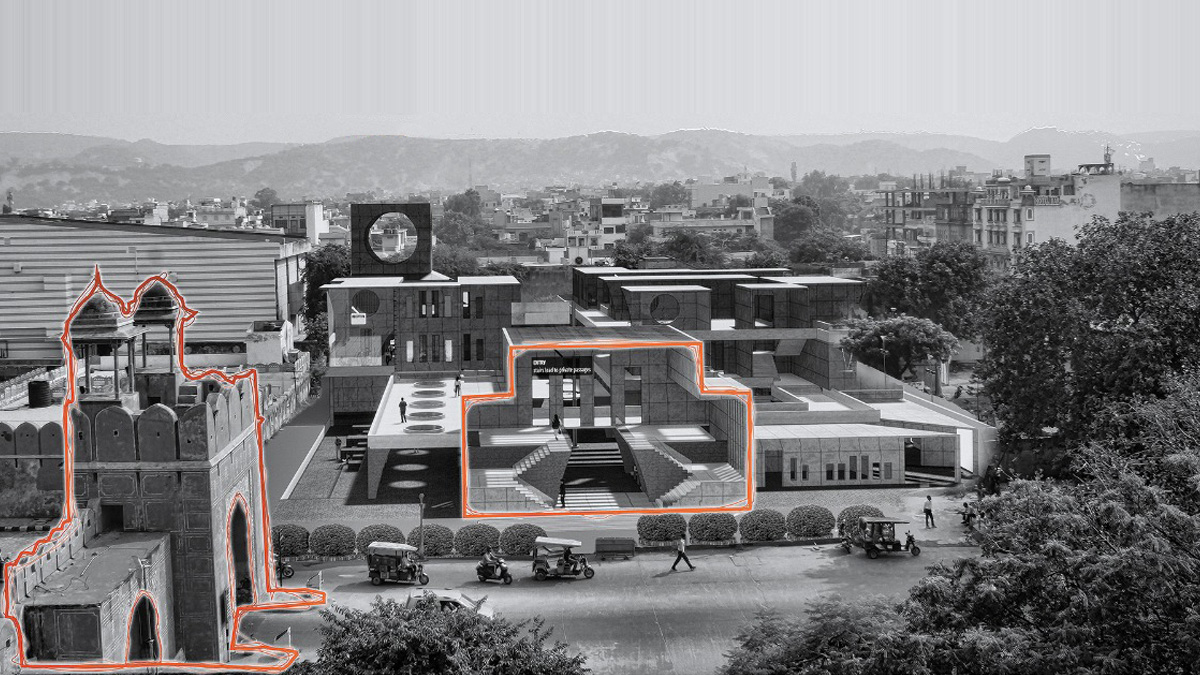 “The idea was to study the proportion of the present heritage of JAIPUR in terms of the height of the city gates, the scale of open courtyards and the terraces and use them in creating a future heritage. One that blends with the current cityscape of Jaipur and uses passive techniques for cooling the way it was used in historical times like in Hawamahal and also using a distinct language of circular openings and forms to create its own identity in this heritage city of Jaipur.”
“The idea was to study the proportion of the present heritage of JAIPUR in terms of the height of the city gates, the scale of open courtyards and the terraces and use them in creating a future heritage. One that blends with the current cityscape of Jaipur and uses passive techniques for cooling the way it was used in historical times like in Hawamahal and also using a distinct language of circular openings and forms to create its own identity in this heritage city of Jaipur.” - Primary Health Care Centre, Panvel – Samruddhi Ugale
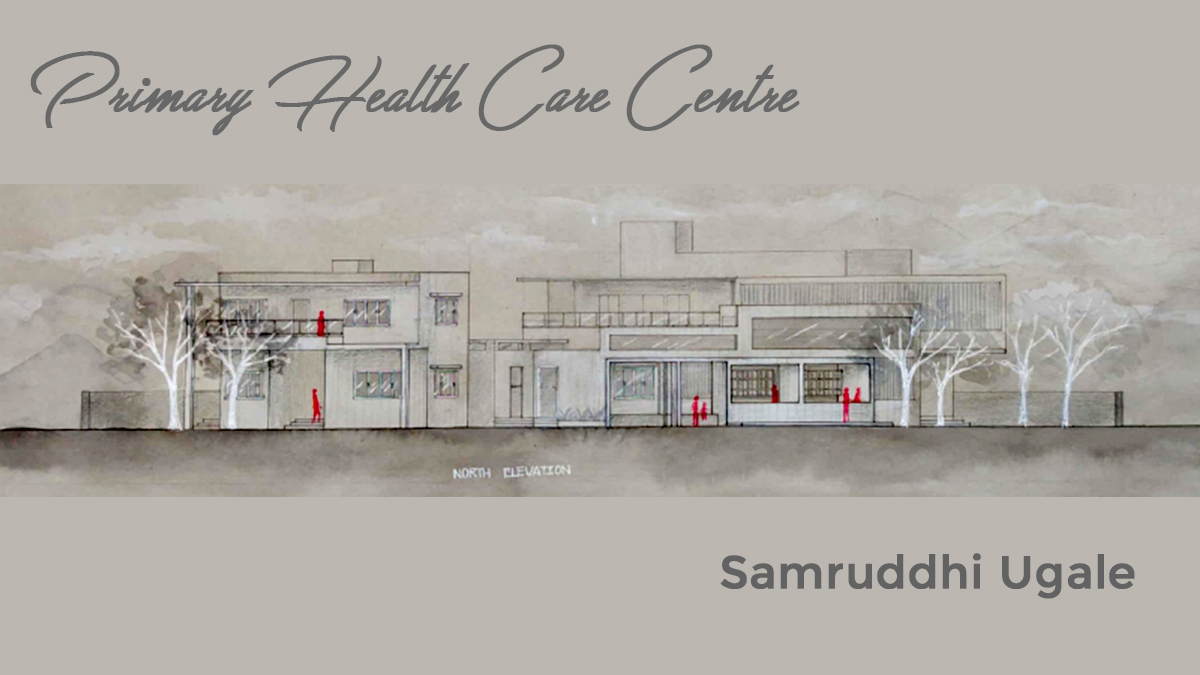 Architectural Design Studio Projects by Students of Semester 4, 2019-2020. 3. Project by: Samruddhi Ugale The objectives of the design studio were aimed for students to design spaces suitable for lifestyle in the rural/semi-urban areas, conserve natural surroundings and social fabric suitable for communities, understand and provide the specific infrastructure required for communities, and combination …
Architectural Design Studio Projects by Students of Semester 4, 2019-2020. 3. Project by: Samruddhi Ugale The objectives of the design studio were aimed for students to design spaces suitable for lifestyle in the rural/semi-urban areas, conserve natural surroundings and social fabric suitable for communities, understand and provide the specific infrastructure required for communities, and combination … - Primary Health Care Centre, Panvel – Vidhiti Shah
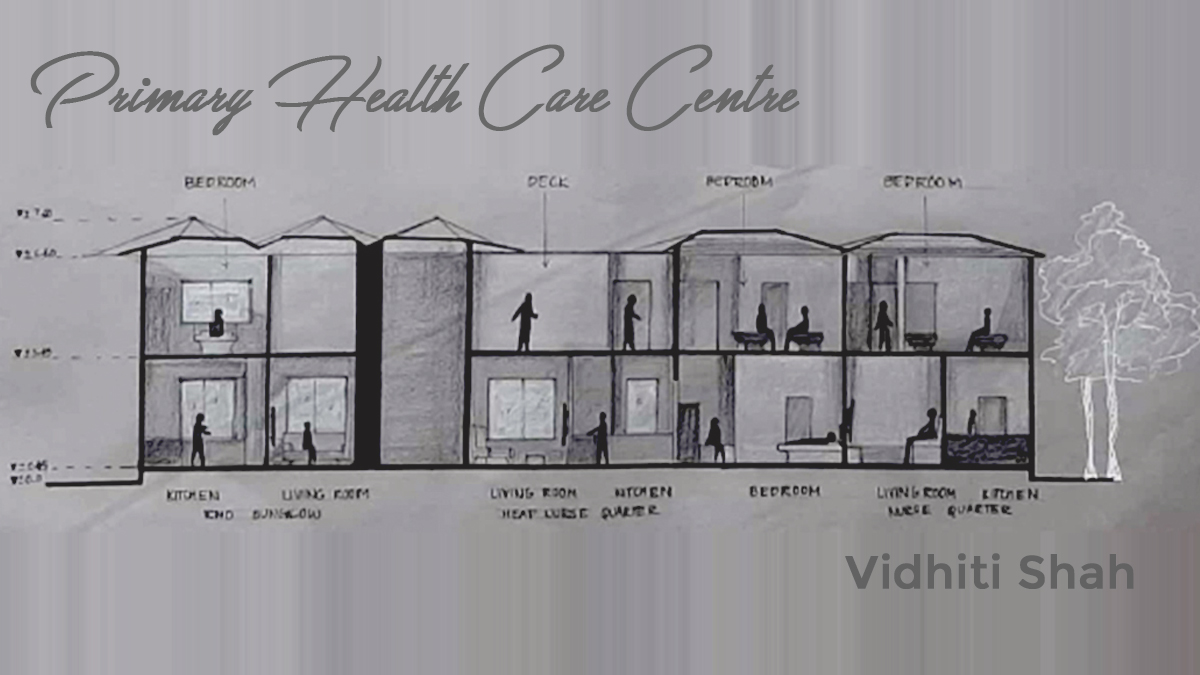 Architectural Design Studio Projects by Students of Semester 4, 2019-2020. 3. Project by: Vidhiti Shah The objectives of the design studio were aimed for students to design spaces suitable for lifestyle in the rural/semi-urban areas, conserve natural surroundings and social fabric suitable for communities, understand and provide the specific infrastructure required for communities, and combination …
Architectural Design Studio Projects by Students of Semester 4, 2019-2020. 3. Project by: Vidhiti Shah The objectives of the design studio were aimed for students to design spaces suitable for lifestyle in the rural/semi-urban areas, conserve natural surroundings and social fabric suitable for communities, understand and provide the specific infrastructure required for communities, and combination … - Primary Health Care Centre, Panvel – Trunal Ghude
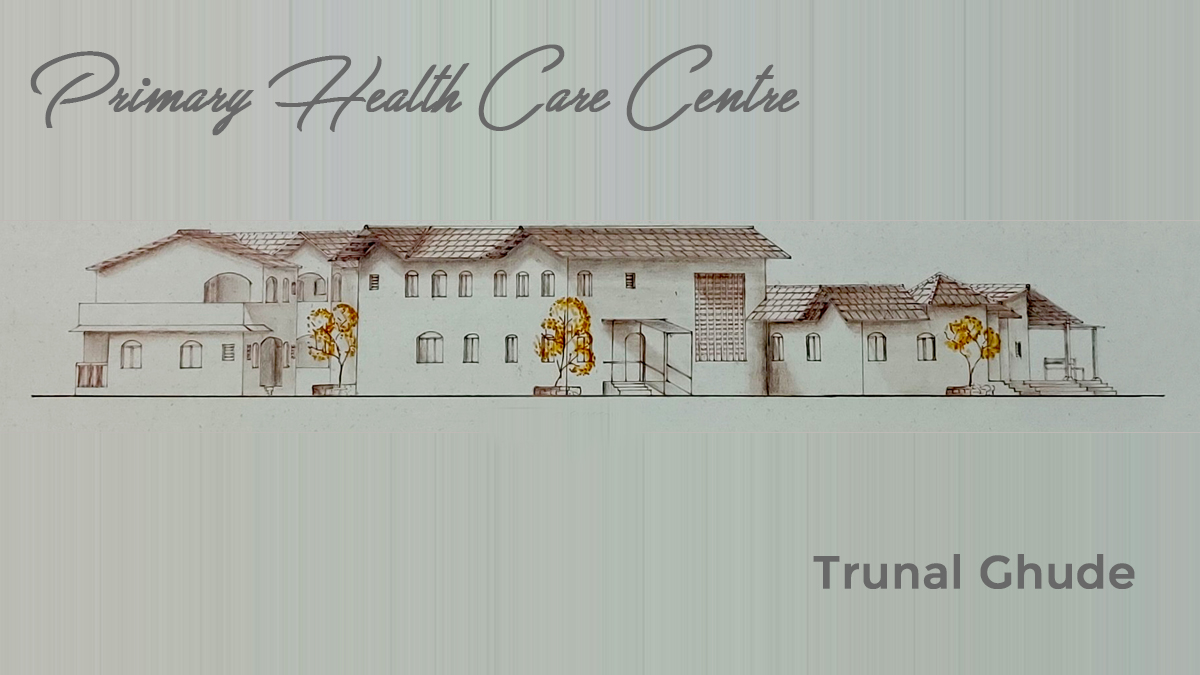 Architectural Design Studio Projects by Students of Semester 4, 2019-2020. 3. Project by: Trunal Ghude The objectives of the design studio were aimed for students to design spaces suitable for lifestyle in the rural/semi-urban areas, conserve natural surroundings and social fabric suitable for communities, understand and provide the specific infrastructure required for communities, and combination …
Architectural Design Studio Projects by Students of Semester 4, 2019-2020. 3. Project by: Trunal Ghude The objectives of the design studio were aimed for students to design spaces suitable for lifestyle in the rural/semi-urban areas, conserve natural surroundings and social fabric suitable for communities, understand and provide the specific infrastructure required for communities, and combination … - Primary Health Care Centre, Panvel – Meghashikha Joshi
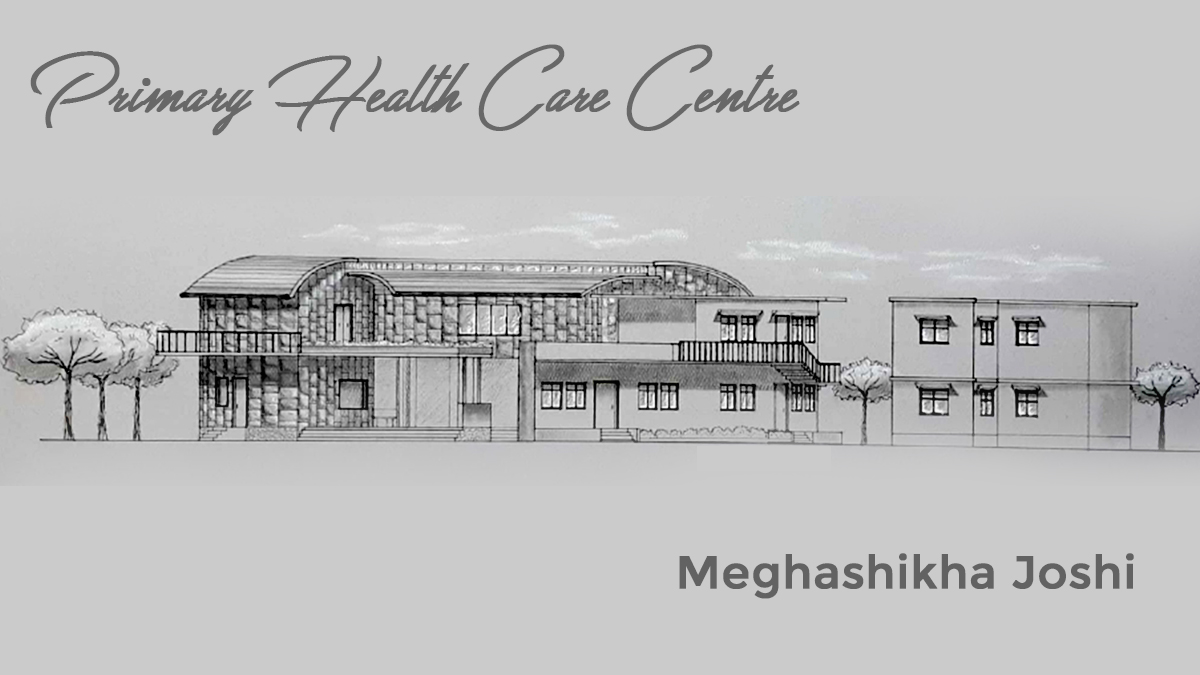 Architectural Design Studio Projects by Students of Semester 4, 2019-2020. 3. Project by: Meghashikha Joshi The objectives of the design studio were aimed for students to design spaces suitable for lifestyle in the rural/semi-urban areas, conserve natural surroundings and social fabric suitable for communities, understand and provide the specific infrastructure required for communities, and combination …
Architectural Design Studio Projects by Students of Semester 4, 2019-2020. 3. Project by: Meghashikha Joshi The objectives of the design studio were aimed for students to design spaces suitable for lifestyle in the rural/semi-urban areas, conserve natural surroundings and social fabric suitable for communities, understand and provide the specific infrastructure required for communities, and combination … - Primary Health Care Centre, Panvel – Rounak Agrawal
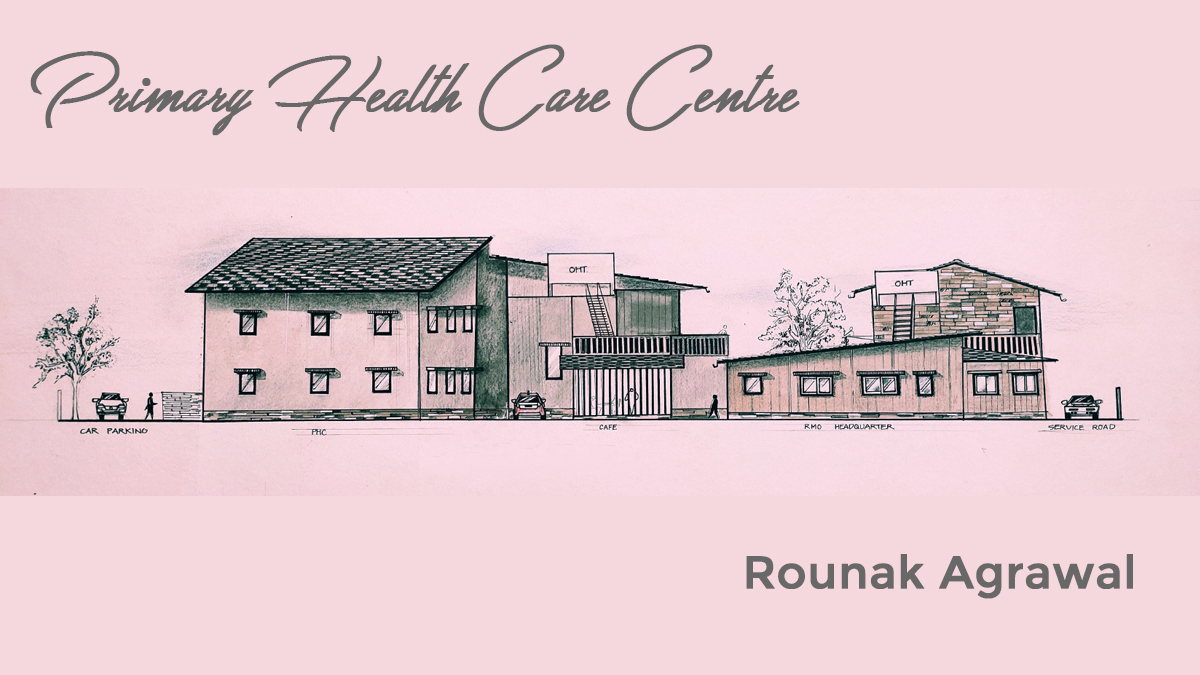 Architectural Design Studio Projects by Students of Semester 4, 2019-2020. 3. Project by: Rounak Agrawal The objectives of the design studio were aimed for students to design spaces suitable for lifestyle in the rural/semi-urban areas, conserve natural surroundings and social fabric suitable for communities, understand and provide the specific infrastructure required for communities, and combination …
Architectural Design Studio Projects by Students of Semester 4, 2019-2020. 3. Project by: Rounak Agrawal The objectives of the design studio were aimed for students to design spaces suitable for lifestyle in the rural/semi-urban areas, conserve natural surroundings and social fabric suitable for communities, understand and provide the specific infrastructure required for communities, and combination … - Primary Health Care Centre, Panvel – Farzan Karkaria
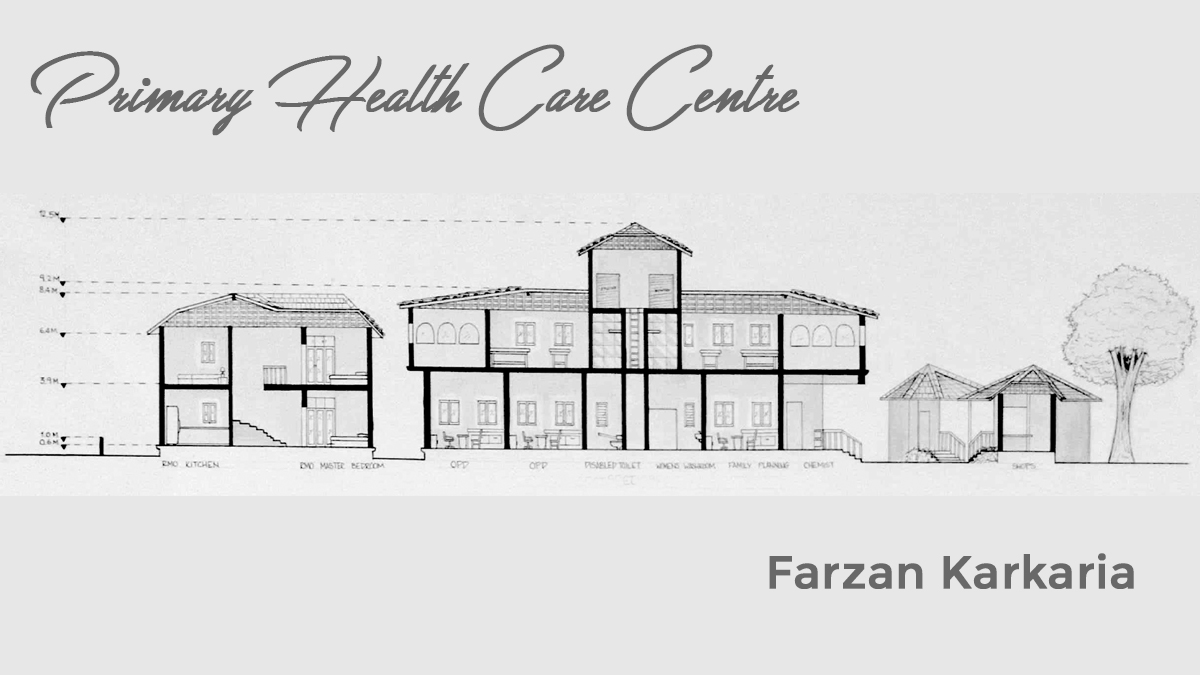 Architectural Design Studio Projects by Students of Semester 4, 2019-2020. 3. Project by: Farzan Karkaria The objectives of the design studio were aimed for students to design spaces suitable for lifestyle in the rural/semi-urban areas, conserve natural surroundings and social fabric suitable for communities, understand and provide the specific infrastructure required for communities, and combination …
Architectural Design Studio Projects by Students of Semester 4, 2019-2020. 3. Project by: Farzan Karkaria The objectives of the design studio were aimed for students to design spaces suitable for lifestyle in the rural/semi-urban areas, conserve natural surroundings and social fabric suitable for communities, understand and provide the specific infrastructure required for communities, and combination … - Primary Health Care Centre, Panvel – Rashi Kondwilkar
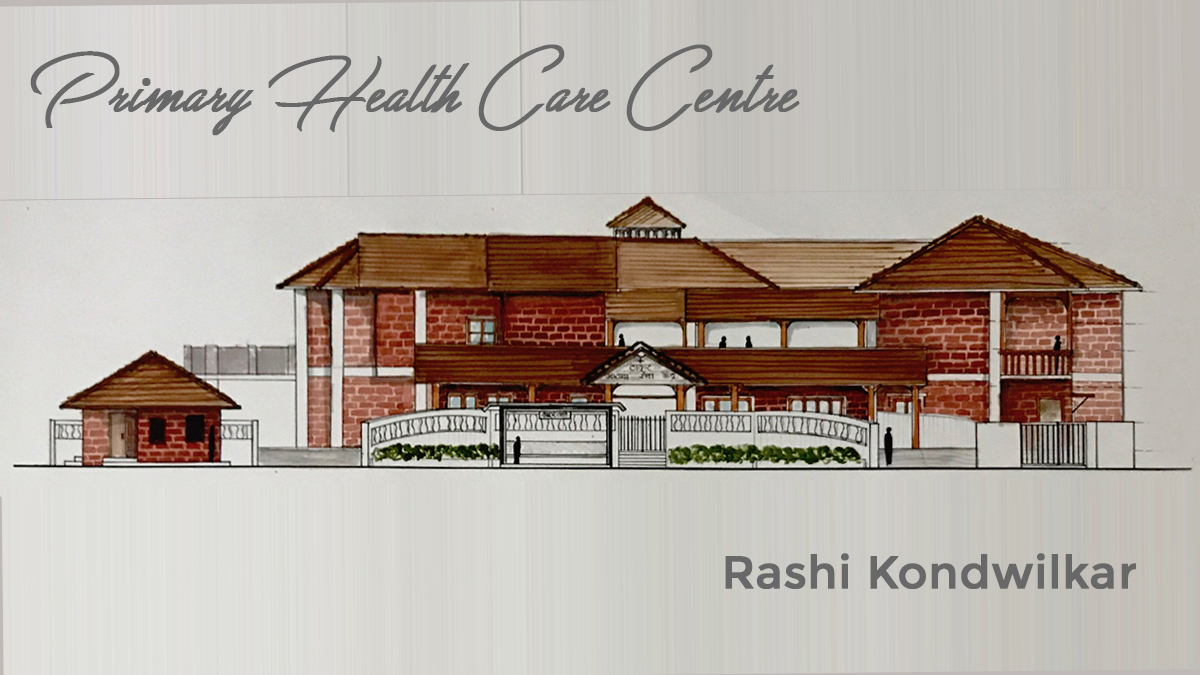 Architectural Design Studio Projects by Students of Semester 4, 2019-2020. 3. Project by: Rashi Kondwilkar The objectives of the design studio were aimed for students to design spaces suitable for lifestyle in the rural/semi-urban areas, conserve natural surroundings and social fabric suitable for communities, understand and provide the specific infrastructure required for communities, and combination …
Architectural Design Studio Projects by Students of Semester 4, 2019-2020. 3. Project by: Rashi Kondwilkar The objectives of the design studio were aimed for students to design spaces suitable for lifestyle in the rural/semi-urban areas, conserve natural surroundings and social fabric suitable for communities, understand and provide the specific infrastructure required for communities, and combination … - Primary Health Care Centre, Panvel – Nishchal Saklecha
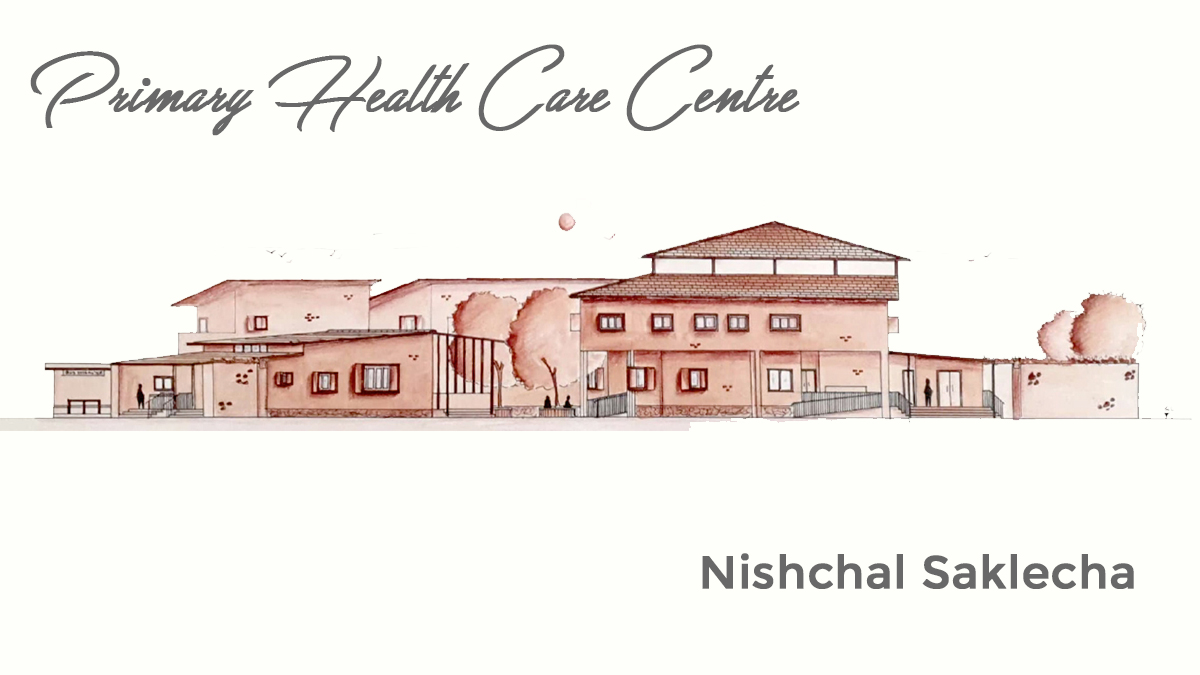 Architectural Design Studio Projects by Students of Semester 4, 2019-2020. 3. Project by: Nishchal Saklecha The objectives of the design studio were aimed for students to design spaces suitable for lifestyle in the rural/semi-urban areas, conserve natural surroundings and social fabric suitable for communities, understand and provide the specific infrastructure required for communities, and combination …
Architectural Design Studio Projects by Students of Semester 4, 2019-2020. 3. Project by: Nishchal Saklecha The objectives of the design studio were aimed for students to design spaces suitable for lifestyle in the rural/semi-urban areas, conserve natural surroundings and social fabric suitable for communities, understand and provide the specific infrastructure required for communities, and combination … - Primary Health Care Centre, Panvel – Sushvi Acharya
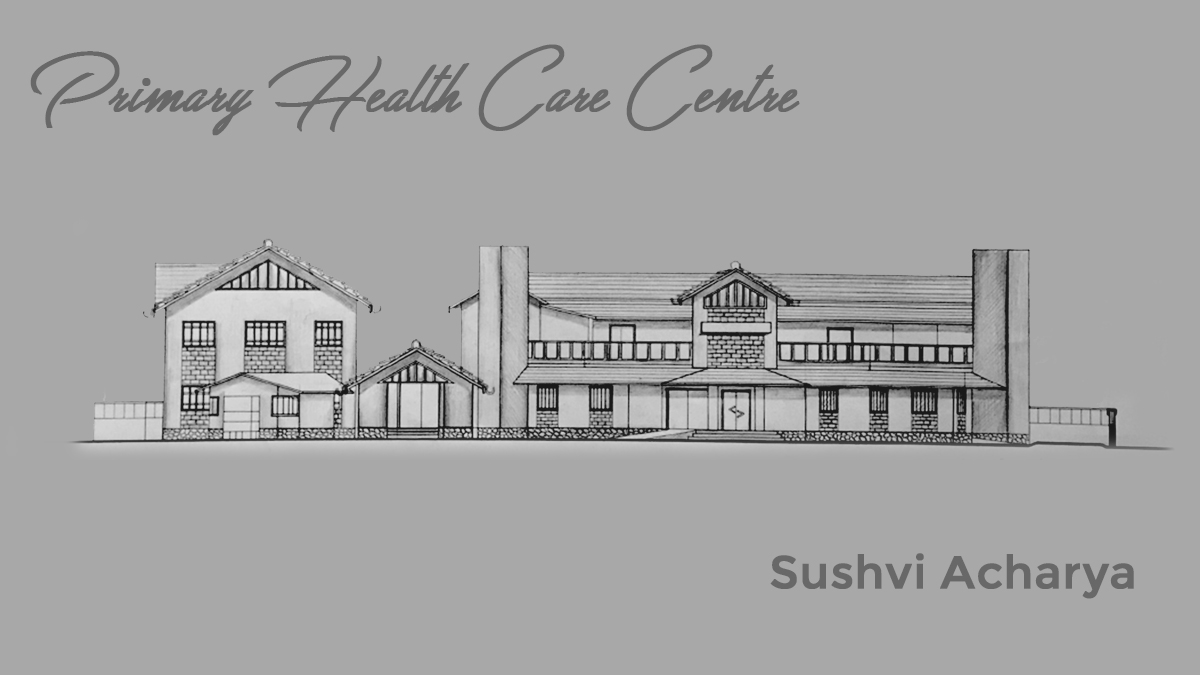 Architectural Design Studio Projects by Students of Semester 4, 2019-2020. 2. Project by: Sushvi Acharya The objectives of the design studio were aimed for students to design spaces suitable for lifestyle in the rural/semi-urban areas, conserve natural surroundings and social fabric suitable for communities, understand and provide the specific infrastructure required for communities, and combination …
Architectural Design Studio Projects by Students of Semester 4, 2019-2020. 2. Project by: Sushvi Acharya The objectives of the design studio were aimed for students to design spaces suitable for lifestyle in the rural/semi-urban areas, conserve natural surroundings and social fabric suitable for communities, understand and provide the specific infrastructure required for communities, and combination … - Primary Health Care Centre, Panvel – Pooja Rajput
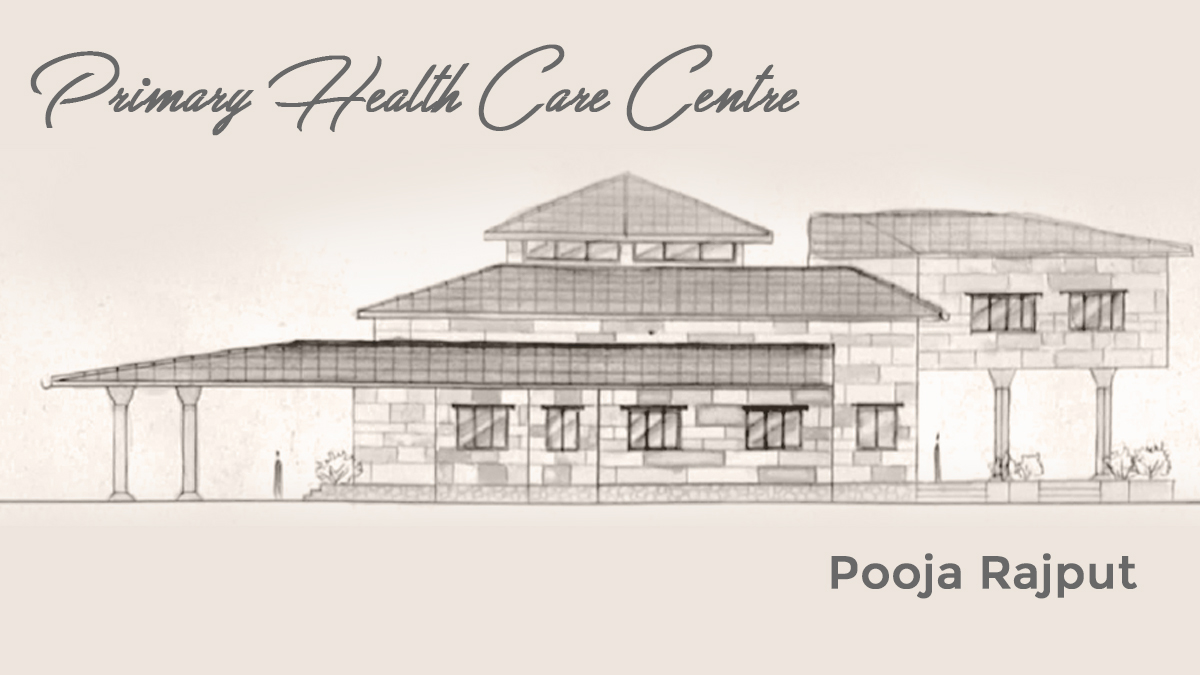 Architectural Design Studio Projects by Students of Semester 4, 2019-2020. 1. Project by: Pooja Rajput The objectives of the design studio were aimed for students to design spaces suitable for lifestyle in the rural/semi-urban areas, conserve natural surroundings and social fabric suitable for communities, understand and provide the specific infrastructure required for communities, and combination …
Architectural Design Studio Projects by Students of Semester 4, 2019-2020. 1. Project by: Pooja Rajput The objectives of the design studio were aimed for students to design spaces suitable for lifestyle in the rural/semi-urban areas, conserve natural surroundings and social fabric suitable for communities, understand and provide the specific infrastructure required for communities, and combination … - Tracing Narratives in Landscapes
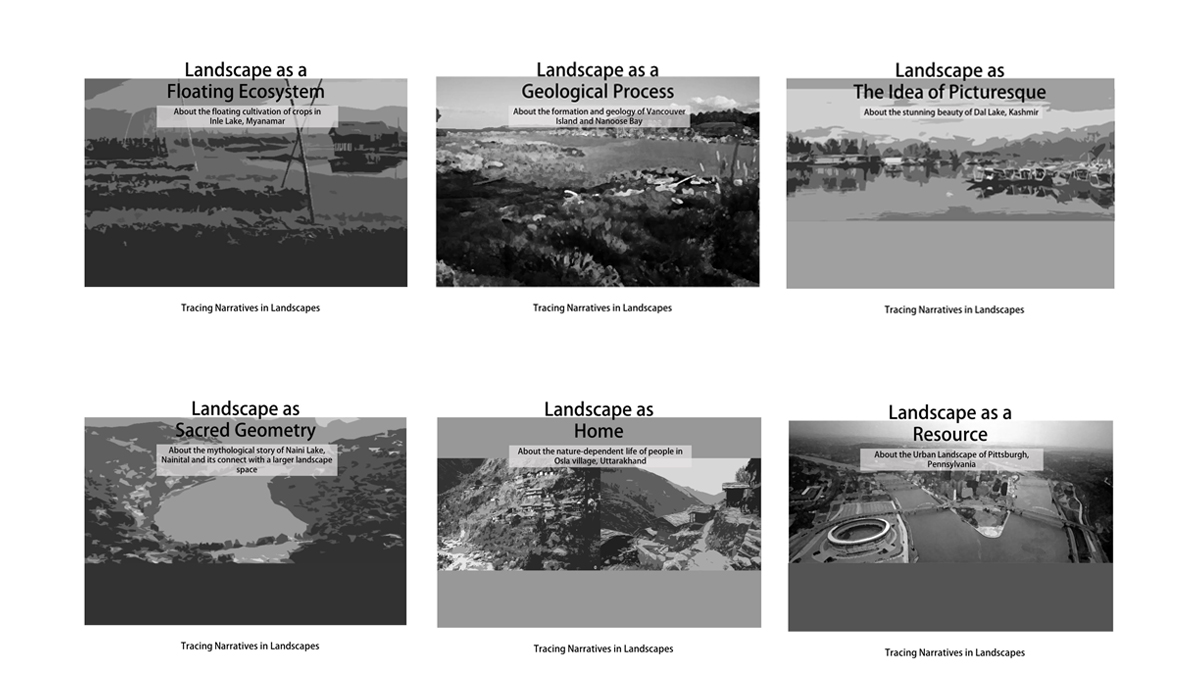 Tutor: Prachi Nadkarni Landscapes as a by-product of interaction between man & nature, have many stories associated with them. The image of a landscape is to some extent the visual evidence of the stories that lie beneath. We observed the “Image” of landscape further in detail and tried identifying the hidden links and ended up …
Tutor: Prachi Nadkarni Landscapes as a by-product of interaction between man & nature, have many stories associated with them. The image of a landscape is to some extent the visual evidence of the stories that lie beneath. We observed the “Image” of landscape further in detail and tried identifying the hidden links and ended up … - Transient Human Environments
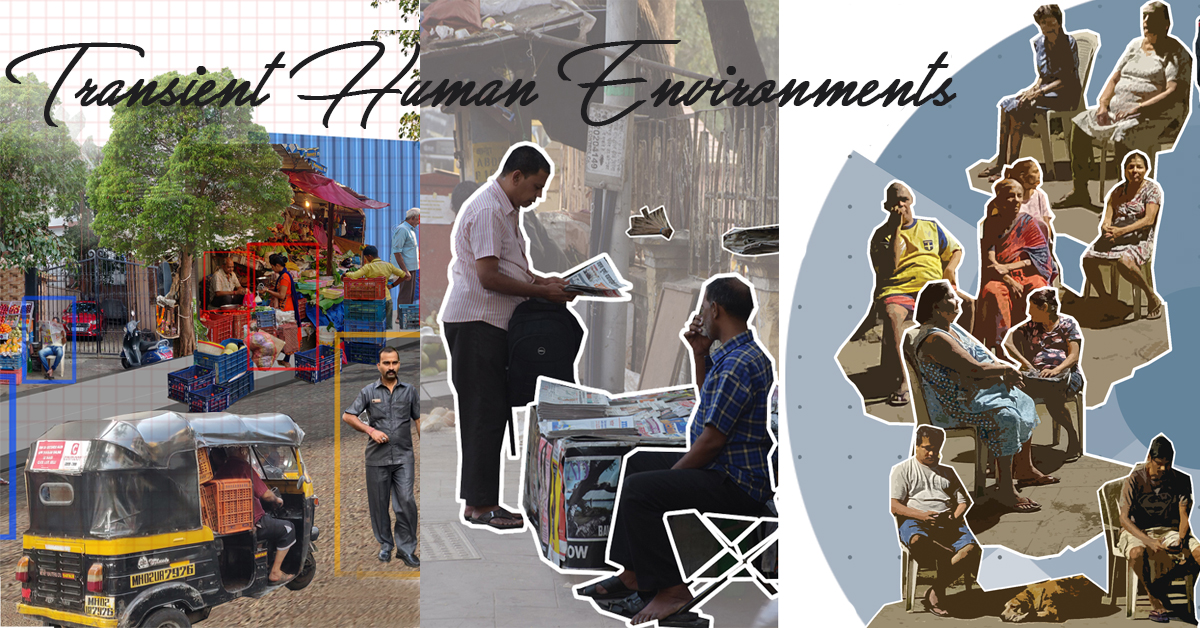 Elective Tutor: Chaitra Sharad ‘Moving elements in a city, and in particular, the people and their activities, are as important as the stationary physical parts. We are not simply observers of this spectacle, but are ourselves a part of it, on the stage with the other participants. Most often, our perception of the city is …
Elective Tutor: Chaitra Sharad ‘Moving elements in a city, and in particular, the people and their activities, are as important as the stationary physical parts. We are not simply observers of this spectacle, but are ourselves a part of it, on the stage with the other participants. Most often, our perception of the city is … - NANHI DUNIYA ANGANWADI
 by Sujay Zende Architectural Design Studio Projects by Students of Semester 2, 2019-20 The Design Studio aimed to achieve an understanding of architecture as an environment for very young children in the context of an Anganwadi. The site taken was in Getipada in the district of Dahanu. The decisions for designing an environment which ensured …
by Sujay Zende Architectural Design Studio Projects by Students of Semester 2, 2019-20 The Design Studio aimed to achieve an understanding of architecture as an environment for very young children in the context of an Anganwadi. The site taken was in Getipada in the district of Dahanu. The decisions for designing an environment which ensured … - HASTA ANGANWADI
 by Vedang Pandeshwar Architectural Design Studio Projects by Students of Semester 2, 2019-20 The Design Studio aimed to achieve an understanding of architecture as an environment for very young children in the context of an Anganwadi. The site taken was in Getipada in the district of Dahanu. The decisions for designing an environment which ensured …
by Vedang Pandeshwar Architectural Design Studio Projects by Students of Semester 2, 2019-20 The Design Studio aimed to achieve an understanding of architecture as an environment for very young children in the context of an Anganwadi. The site taken was in Getipada in the district of Dahanu. The decisions for designing an environment which ensured … - PUDHCHA PAOOL ANGANWADI
 by Vaishnavi Desai Architectural Design Studio Projects by Students of Semester 2, 2019-20 The Design Studio aimed to achieve an understanding of architecture as an environment for very young children in the context of an Anganwadi. The site taken was in Getipada in the district of Dahanu. The decisions for designing an environment which ensured …
by Vaishnavi Desai Architectural Design Studio Projects by Students of Semester 2, 2019-20 The Design Studio aimed to achieve an understanding of architecture as an environment for very young children in the context of an Anganwadi. The site taken was in Getipada in the district of Dahanu. The decisions for designing an environment which ensured … - GURUKUL ANGANWADI
 by Surochis Ghag Architectural Design Studio Projects by Students of Semester 2, 2019-20 The Design Studio aimed to achieve an understanding of architecture as an environment for very young children in the context of an Anganwadi. The site taken was in Getipada in the district of Dahanu. The decisions for designing an environment which ensured …
by Surochis Ghag Architectural Design Studio Projects by Students of Semester 2, 2019-20 The Design Studio aimed to achieve an understanding of architecture as an environment for very young children in the context of an Anganwadi. The site taken was in Getipada in the district of Dahanu. The decisions for designing an environment which ensured … - KILBIL ANGANWADI
 by Snehal Jadhav Architectural Design Studio Projects by Students of Semester 2, 2019-20 The Design Studio aimed to achieve an understanding of architecture as an environment for very young children in the context of an Anganwadi. The site taken was in Getipada in the district of Dahanu. The decisions for designing an environment which ensured …
by Snehal Jadhav Architectural Design Studio Projects by Students of Semester 2, 2019-20 The Design Studio aimed to achieve an understanding of architecture as an environment for very young children in the context of an Anganwadi. The site taken was in Getipada in the district of Dahanu. The decisions for designing an environment which ensured … - VATSALYA ANGANWADI
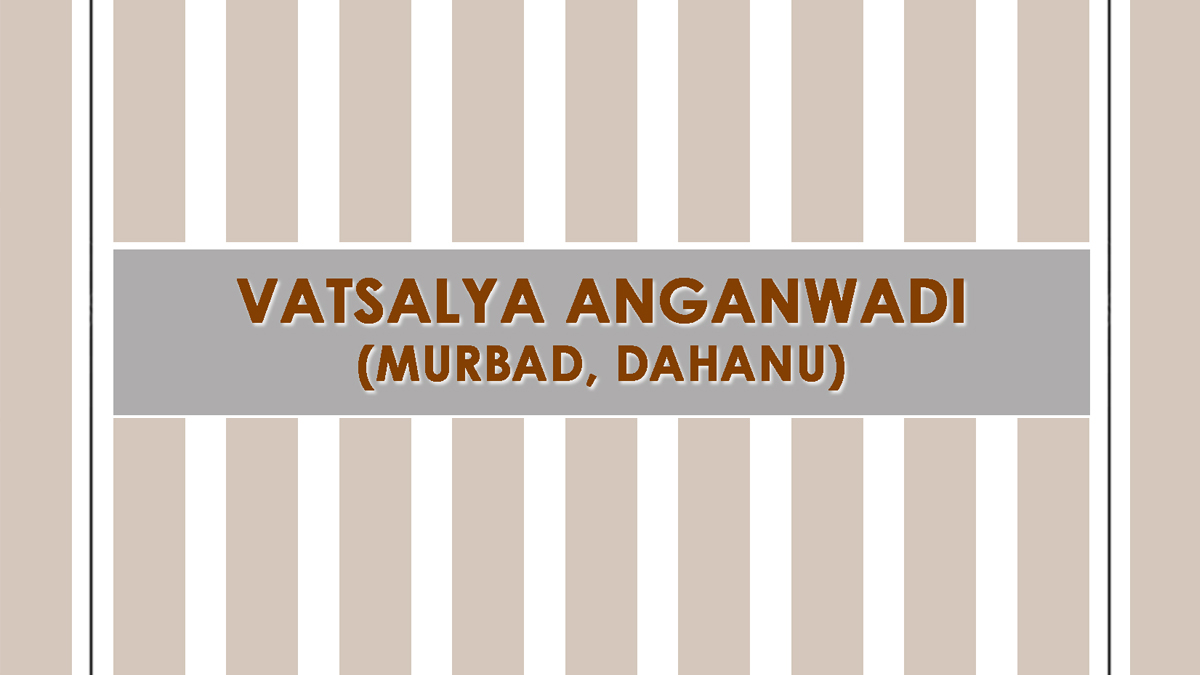 by Shrutika Walunj Architectural Design Studio Projects by Students of Semester 2, 2019-20 The Design Studio aimed to achieve an understanding of architecture as an environment for very young children in the context of an Anganwadi. The site taken was in Getipada in the district of Dahanu. The decisions for designing an environment which ensured …
by Shrutika Walunj Architectural Design Studio Projects by Students of Semester 2, 2019-20 The Design Studio aimed to achieve an understanding of architecture as an environment for very young children in the context of an Anganwadi. The site taken was in Getipada in the district of Dahanu. The decisions for designing an environment which ensured … - DNYANAVARDHINI ANGANWADI
 by Prathamesh Patil Architectural Design Studio Projects by Students of Semester 2, 2019-20 The Design Studio aimed to achieve an understanding of architecture as an environment for very young children in the context of an Anganwadi. The site taken was in Getipada in the district of Dahanu. The decisions for designing an environment which ensured …
by Prathamesh Patil Architectural Design Studio Projects by Students of Semester 2, 2019-20 The Design Studio aimed to achieve an understanding of architecture as an environment for very young children in the context of an Anganwadi. The site taken was in Getipada in the district of Dahanu. The decisions for designing an environment which ensured … - SLUSH ANGANWADI
 by Lalit Dahivalikar Architectural Design Studio Projects by Students of Semester 2, 2019-20 The Design Studio aimed to achieve an understanding of architecture as an environment for very young children in the context of an Anganwadi. The site taken was in Getipada in the district of Dahanu. The decisions for designing an environment which ensured …
by Lalit Dahivalikar Architectural Design Studio Projects by Students of Semester 2, 2019-20 The Design Studio aimed to achieve an understanding of architecture as an environment for very young children in the context of an Anganwadi. The site taken was in Getipada in the district of Dahanu. The decisions for designing an environment which ensured … - MUKTANGAN ANGANWADI
 by Gargi Kulkarni Architectural Design Studio Projects by Students of Semester 2, 2019-20 The Design Studio aimed to achieve an understanding of architecture as an environment for very young children in the context of an Anganwadi. The site taken was in Getipada in the district of Dahanu. The decisions for designing an environment which ensured …
by Gargi Kulkarni Architectural Design Studio Projects by Students of Semester 2, 2019-20 The Design Studio aimed to achieve an understanding of architecture as an environment for very young children in the context of an Anganwadi. The site taken was in Getipada in the district of Dahanu. The decisions for designing an environment which ensured … - SHISHUNIKETAN ANGANWADI
 by Daksh Jain Architectural Design Studio Projects by Students of Semester 2, 2019-20 The Design Studio aimed to achieve an understanding of architecture as an environment for very young children in the context of an Anganwadi. The site taken was in Getipada in the district of Dahanu. The decisions for designing an environment which ensured …
by Daksh Jain Architectural Design Studio Projects by Students of Semester 2, 2019-20 The Design Studio aimed to achieve an understanding of architecture as an environment for very young children in the context of an Anganwadi. The site taken was in Getipada in the district of Dahanu. The decisions for designing an environment which ensured … - SAUBHAGYA ANGANWADI
 by Archana Mandhan Architectural Design Studio Projects by Students of Semester 2, 2019-20 The Design Studio aimed to achieve an understanding of architecture as an environment for very young children in the context of an Anganwadi. The site taken was in Getipada in the district of Dahanu. The decisions for designing an environment which ensured …
by Archana Mandhan Architectural Design Studio Projects by Students of Semester 2, 2019-20 The Design Studio aimed to achieve an understanding of architecture as an environment for very young children in the context of an Anganwadi. The site taken was in Getipada in the district of Dahanu. The decisions for designing an environment which ensured … - VERTICAL TRANSPORTATION SYSTEMS
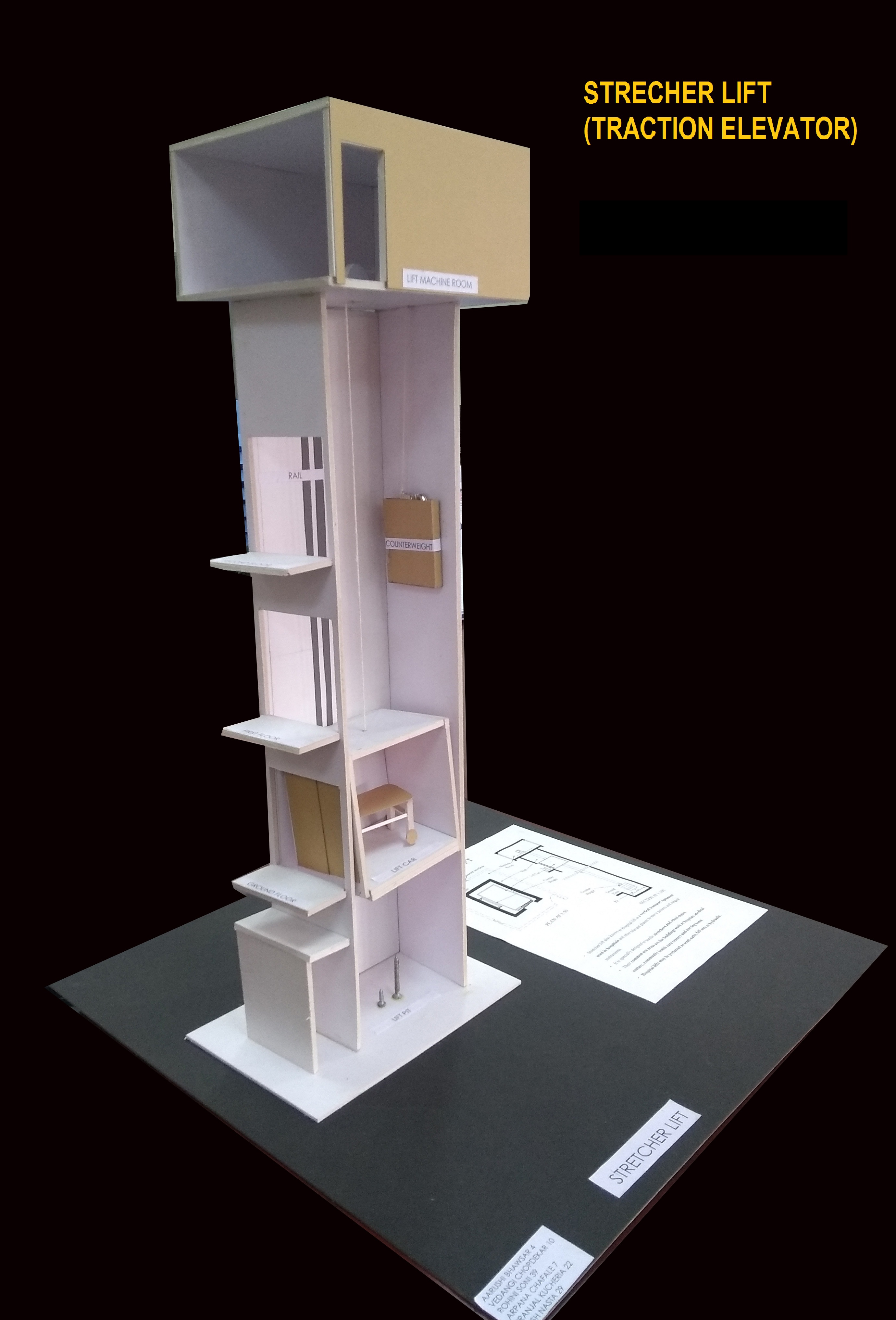 The students of 3rd Year (6th Semester) were taught Vertical Transportation Systems as part of their Architectural Building Services curriculum. For this particular topic, the class was divided into nine groups. Each group were given a sub-topic, mentioned below; History and Evolution of Lifts Passenger Lift Stretcher Lift Car Lifts Service Lifts Construction Lifts …
The students of 3rd Year (6th Semester) were taught Vertical Transportation Systems as part of their Architectural Building Services curriculum. For this particular topic, the class was divided into nine groups. Each group were given a sub-topic, mentioned below; History and Evolution of Lifts Passenger Lift Stretcher Lift Car Lifts Service Lifts Construction Lifts …
Get new content delivered directly to your inbox.
[jetpack_subscription_form subscribe_placeholder=”Enter your email address” show_subscribers_total=”false” button_on_newline=”false” submit_button_text=”Sign Up” custom_font_size=”16px” custom_border_radius=”0″ custom_border_weight=”1″ custom_padding=”15″ custom_spacing=”10″ submit_button_classes=”” email_field_classes=”” show_only_email_and_button=”true”]
